Last updated October 2022 | Words and photos by Vietnam Coracle
INTRODUCTION | GUIDE | MAP | RELATED POSTS
I’m no botanist (which, no doubt, will become clear as you read through this article), but I do love flowers, plants, and trees. When I started living in Vietnam and, in particular, when I started making road trips through the countryside, I was mesmerized by the colours, smells, shapes, sizes and variety of the flora I saw. But, for the most part, I couldn’t identify them by name, so I wasn’t able to communicate what I was seeing, whether in conversation, in writing, or in my own thoughts. I wanted to have words for these beautiful things, I wanted to learn the lexicon of nature. So I bought a few illustrated books about tropical foliage – ‘plant-spotting guides’ – and, within a couple of weeks on the road, I’d ticked off 90% of what was in them. This greatly enhanced my experience of nature in Vietnam and helped me engage with, and get closer to, the things I was seeing. On this page, I’ve compiled an informal, illustrated list of some of the flowers, plants and trees I regularly see in Vietnam’s cities and countryside, in the hope this may be something other travellers, road-trippers, and expats may find interesting too. There are two indexes: Flowers & Plants | Fruits & Trees
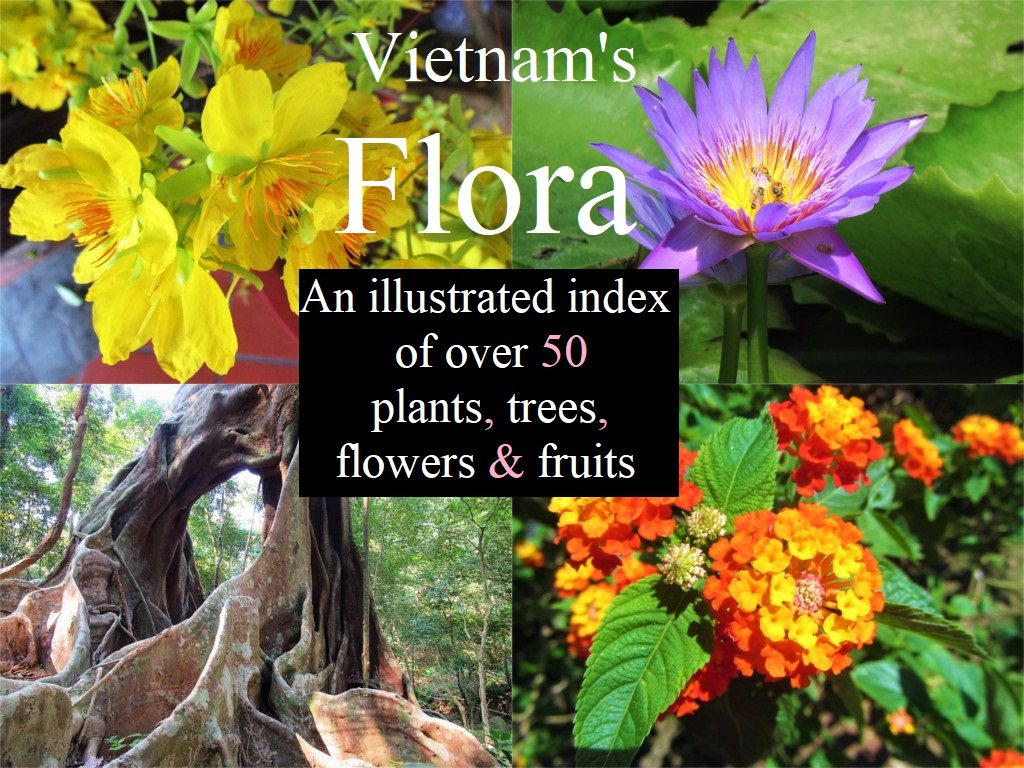
[Back Top]
GUIDE: FLOWERS, PLANTS, FRUITS & TREES
The list below is organized into two categories: Flowers & Plants and Fruits & Trees. I know that many of the items technically belong in both categories, but I have simply chosen to put each one in the category that I most associate it with. Other than that, there’s no order to the following list, and I will continue to add to this index regularly. For every flower, plant, fruit and tree in this list, I’ve included images and a brief description. This is in no way a scholarly work and, in most cases, I much prefer using the colloquial names (which are often romantic-sounding and rich with exotic connotations), rather than the less accessible, Latin-based, scientific names. Also, where my limited knowledge allows, I’ve included the Vietnamese names, which are often very poetic, too.
Click an item from the two indexes below: Flowers & Plants | Fruits & Trees:
- Frangipani
- African Tulip
- Lantana
- Hibiscus
- Rangoon Creeper
- Bougainvillea
- Sweet Pea
- Crown Flower
- Spider Lily
- Angel’s Trumpet
- Yellow Mimosa
- Water Lily
- Flame Vine
- Madagascar Periwinkle
- Yellow Oleander
- Orchid Tree
- Ixora
- Lipstick Tree
- Morning Glory
- Golden Shower
- Peacock Flower
- Rose Myrtle
- Poinsettia
- Heliconia
- Yellow Mai Flower
- Adenium
- Lotus Flower

- Flame Tree
- Jackfruit Tree
- Copperpod Tree
- Teak Tree
- Coconut Palm
- Tropical Almond
- Indian Milkwood Pine
- Tamarind Tree
- Prickly Pear Cactus
- Star Apple
- Kapok Tree
- Papaya Tree
- Traveller’s Palm
- Persimmon Tree
- Grape Vine
- Casuarina Tree
- Dragon Fruit Tree
- Chilli Pepper
- Banyan Tree
- Bodhi Tree
- Peanut
- Cannonball Tree
- Bamboo
- Cashew Tree
- Mango Tree
- Coffee Bush
- Breadfruit Tree
MAP:
A General Map of the Geographical Regions of Vietnam
View in a LARGER MAP
INDEX: FLOWERS & PLANTS
*Other names: Hoa Sứ (Vietnamese) | Plumeria (Latin)
*Where & when you might see it: south, south-central & central coast, Mekong Delta [MAP]
This milky white flower with a lemon-yellow tinge has a scent that draws me to it like a Siren’s song. I can still remember when I first became aware of it: on the beach at Ho Tram. The perfume is citrusy and sweet; rich and refreshing in the heat of the day or a humid evening. I don’t know why, but its affect on me is profound. Ever since I first smelt it, I felt as though this flower meant something to me. Its name is Italian, and apparently comes from a 16th century duchess who was so enamored of the scent of the flower that she ordered her servants to concoct a perfume from it. Her family name was Frangipani. In Vietnamese, hoa sứ means ‘porcelain flower’, so-named because of its whiteness. But Frangipani come in other varieties, including smaller flowers in pink and purple. They all carry the same beautiful scent.

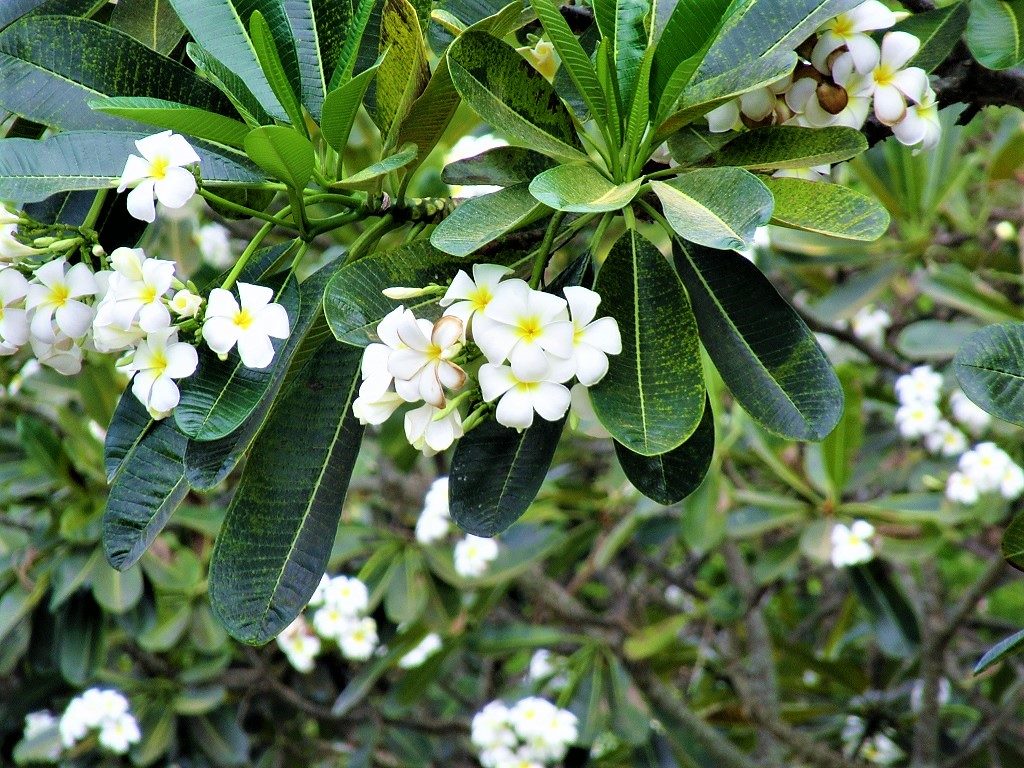
African Tulip:
*Other names: Spathodea (Latin)
*Where & when you might see it: Mekong Delta, southern & central coasts, dry season months (November-May) [MAP]
This medium-sized tree lives up to its romantic name thanks to the brilliant red-orange flowers which grow at the tip of each branch, looking like lanterns burning along the boughs. I see it most often in coastal resorts on the southern coast or Phu Quoc Island, where African Tulip trees are planted for their aesthetic value.

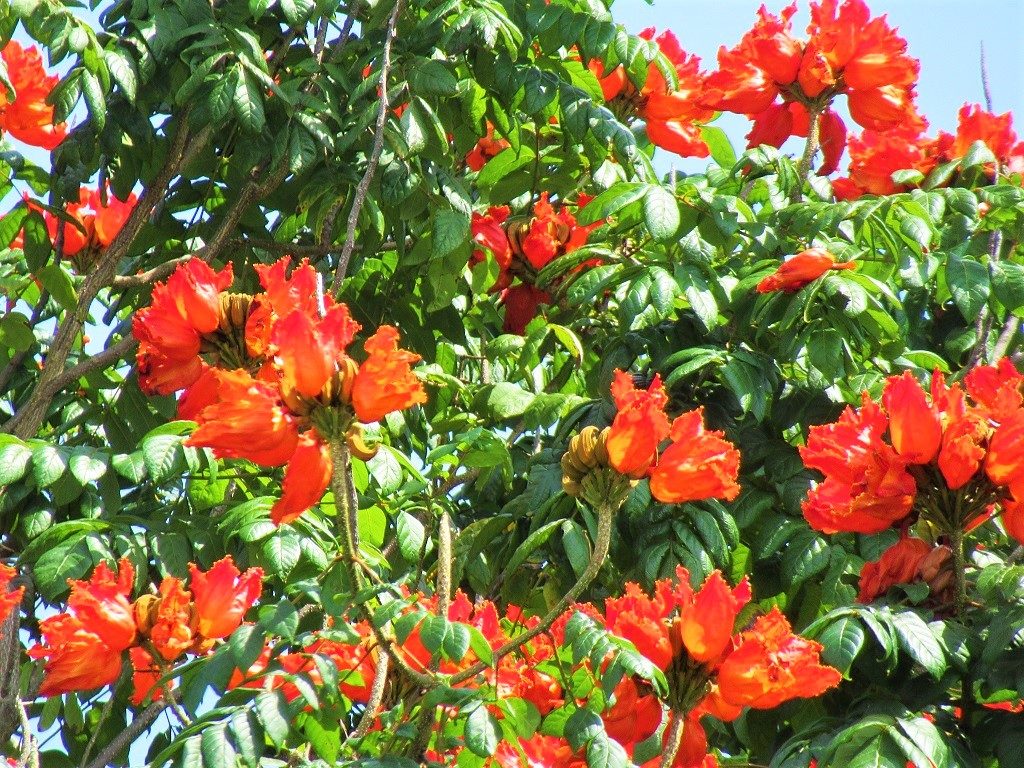
Lantana:
*Other names: Ngũ sắc (Vietnamese)
*Where & when you might see it: coastal regions, particularly south & central [MAP]
This pretty little flower grows on a shrub-like bush, especially by the sea. The flowers are a bouquet of small clusters in many colours: red, yellow, violet, orange, pink. In fact, the Vietnamese name (ngũ sắc) describes them perfectly, meaning ‘five colours’. But the most attractive aspect of Lantana for me, is the textured, slightly serrated, mint-like leaves which, when you rub them, give off an attractive scent that reminds me of essential oils.

Hibiscus:
*Other names: Chi râm bụt (Vietnamese)
*Where & when you might see it: all over the tropical south: along the coast and in the highlands [MAP]
A beautiful flower which comes is many colours and sizes, hibiscus is as close as you can get to the perfect form of a flower. Shapely, delicate and attractive, but without any scent, hibiscus grow on bushes all over the tropical southern coastal and highland regions. A familiar sight in the grounds of Buddhist temples and beach resorts, hibiscus are often grown as ornamental flowers. But I’ve also heard of a symbolic connection with Buddhism: something about the transience of life represented by the brief blooming of the flower, which closes and withers at dusk.

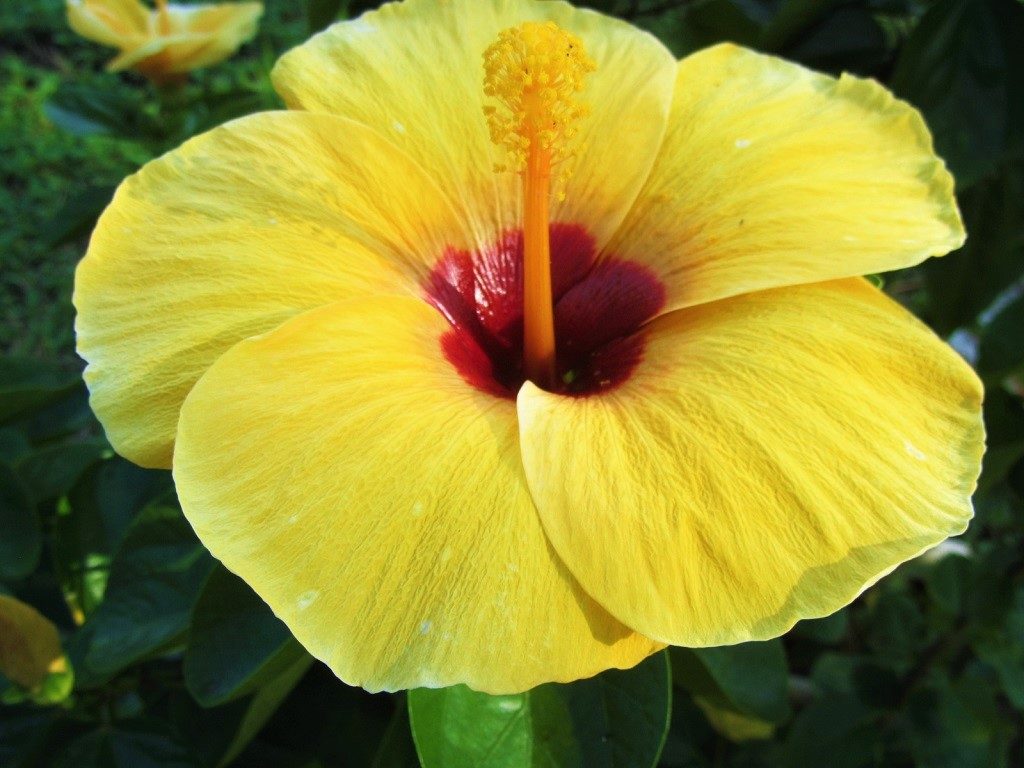
Rangoon Creeper:
*Other names: Chinese honeysuckle | Sử quân tử or trang leo (Vietnamese)
*Where & when you might see it: coastal and midland regions [MAP]
With an evocative name and a perfume to match, the Rangoon creeper has been a favourite of mine ever since I first caught its scent on the breeze somewhere in Vietnam many years ago. Also known as Chinese honeysuckle, its aroma is seductive and irresistible, attracting all who pass by. Sweet and floral, the scent induces joy and excitement in me. The plant itself is a vine which grows up walls, fences, trellises, and entrances. The delicate flowers grow in little bunches of pink, purple and white. If I ever have my own house in the tropics, the doorway will be framed with a Rangoon creeper.

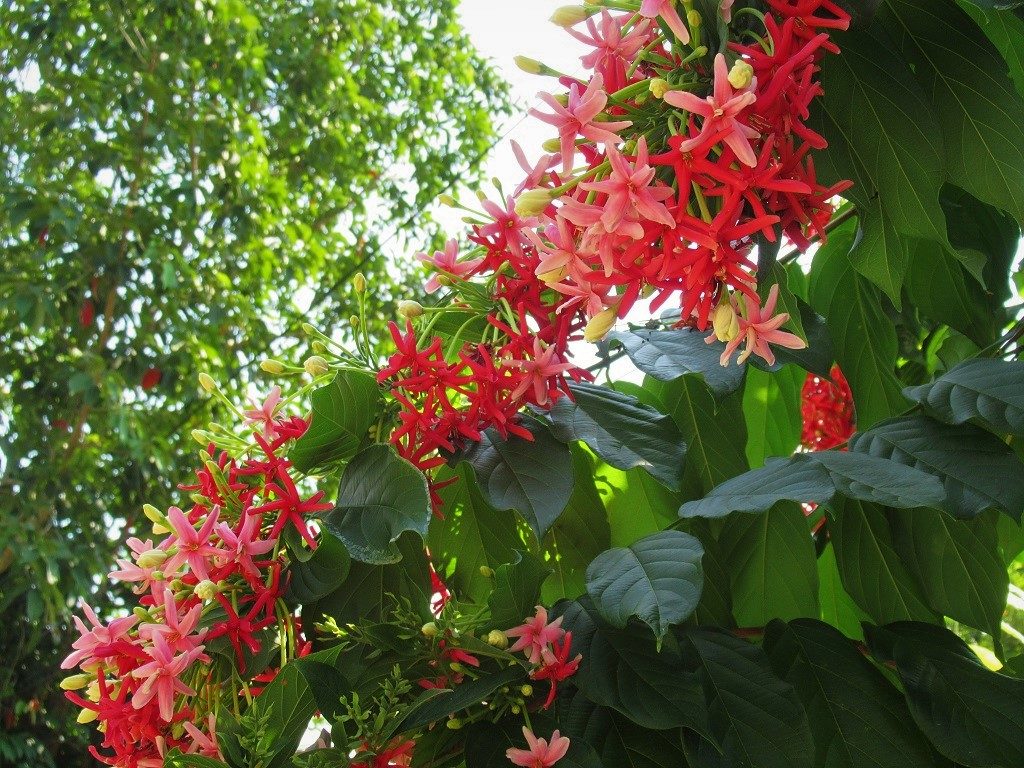
Bougainvillea:
*Other names: Hoa giấy (Vietnamese)
*Where & when you might see it: coastal regions of southern & central provinces & Central Highlands [MAP]
The pink, purple and white petals of bougainvillea have always been symbolic of warm climes and blue seas. My first recollection of bougainvillea is in Greece, where the flowers shine out from the white-washed walls over which they grow. In Vietnam, too, bougainvillea has a similar radiance: growing over doorways and entrances to people’s homes by the coast, decorating gardens in the highlands, and showering the porches of al fresco restaurants in fishing villages. Its luminescence is hypnotic, joyful and magnetic: when I see a bougainvillea vine in the sun, I want to be under it, basking in its colour. The Vietnamese name, hoa giấy, means ‘paper flower’, because of the fine, translucence of its petals.
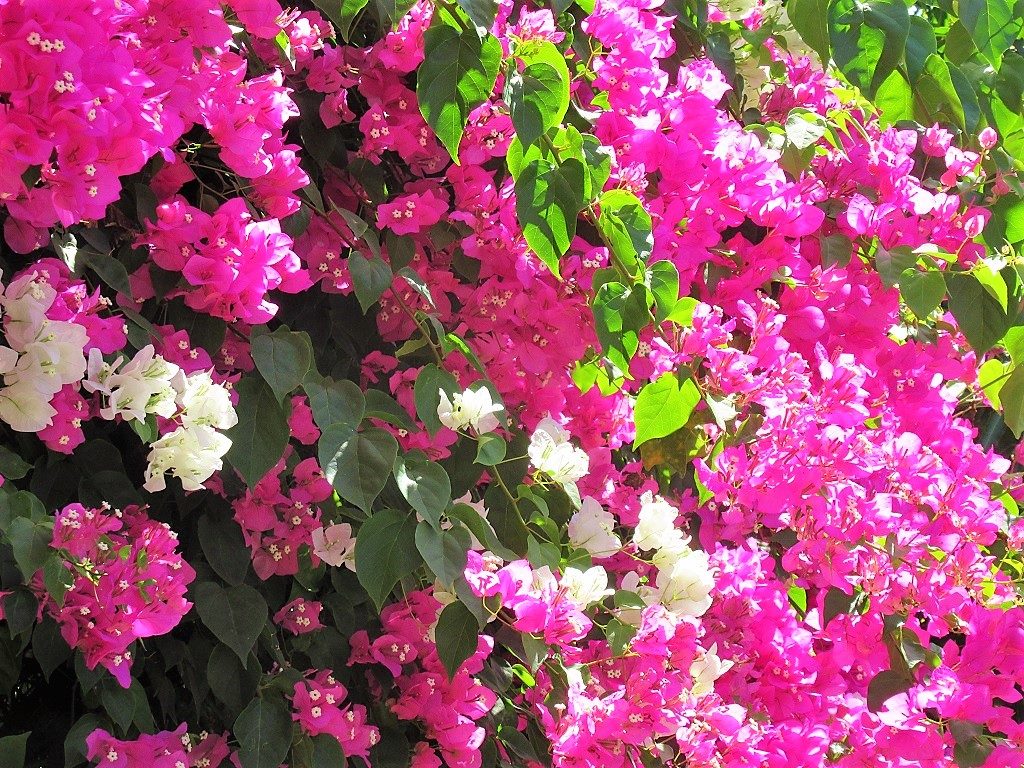

Sweet Pea:
*Other names: Hoa Hương Đậu (Vietnamese)
*Where & when you might see it: Southern Central Highlands [MAP]
Delicate purple, white and pink flowers and a glorious fragrance that puts the world’s perfumeries to shame, make Sweet Pea one of the prettiest and most seductive of flowers. But it’s rare: I don’t see Sweet Pea much in Vietnam, but when I do (I can smell it before I see it), it’s usually in the Central Highlands, particularly in the mountain resort city of Dalat, where it adorns some of the former French colonial villas.
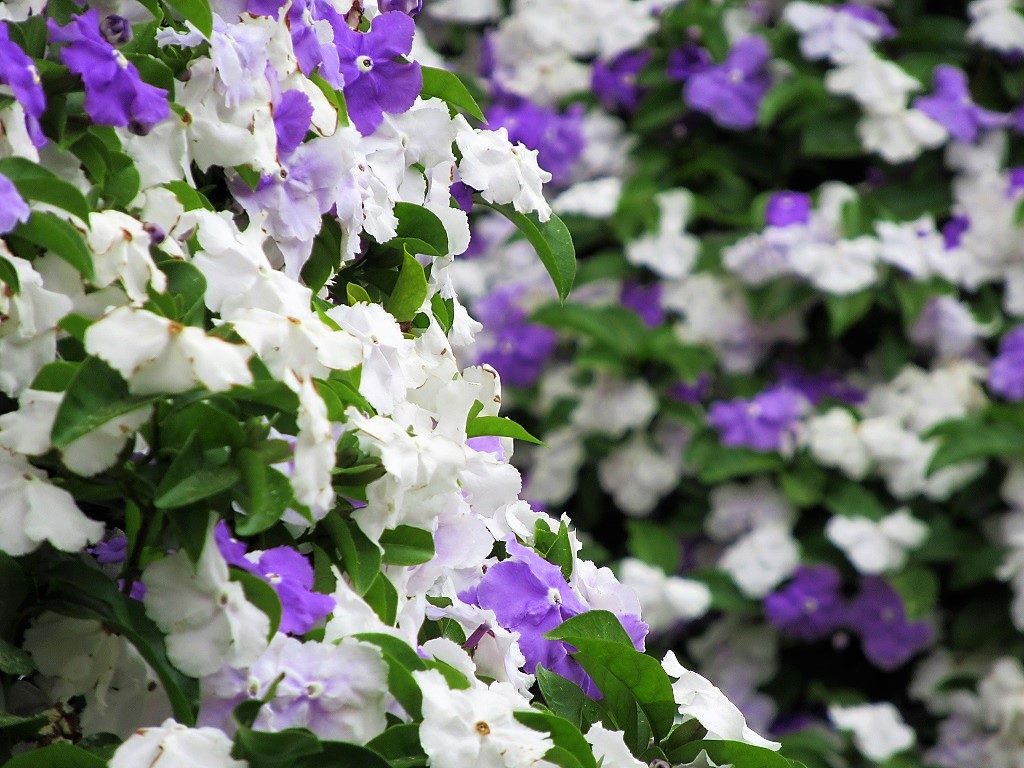

Crown Flower:
*Other names: Chi bòng bòng (Vietnamese)
*Where & when you might see it: Along the southern & central coast & islands [MAP]
A distinctive white and violet, star-shaped flower, the Crown Plant is a common sight all along Vietnam’s coastline. It’s a bush-like plant which appears to grow like a weed along the high-tide mark of sandy beaches. The leaves and flowers are stiff and slightly shiny: almost as if they were made of rubber. In the centre of each star-shaped flower, a five-sided stigma protrudes, looking like a royal crown.
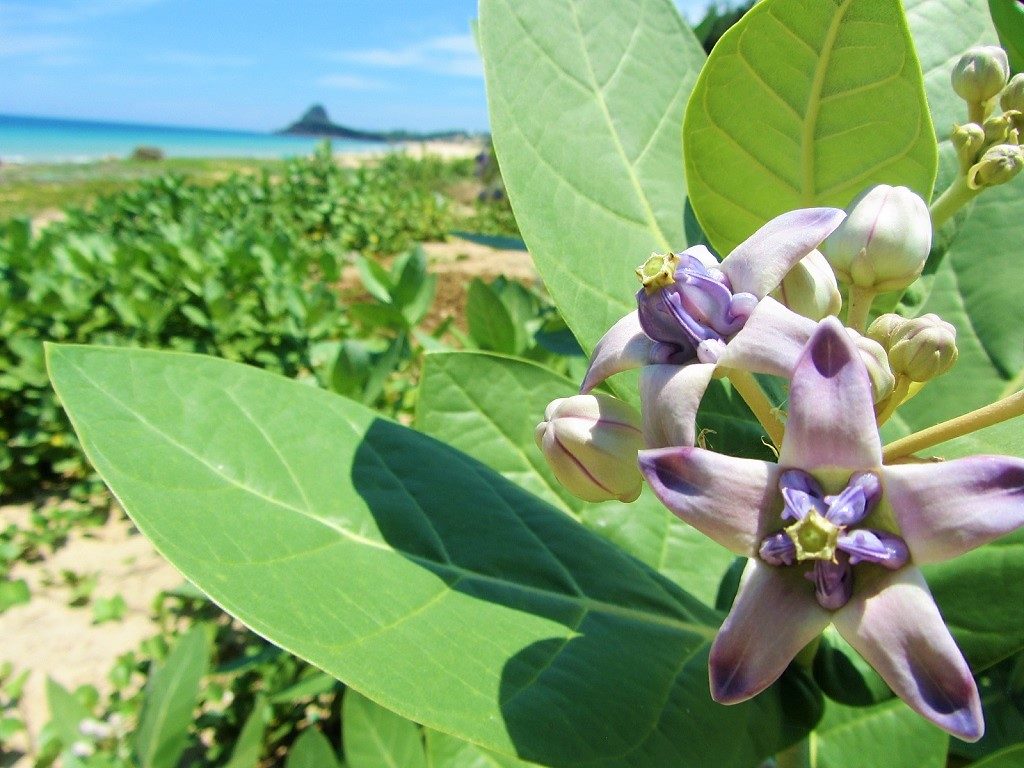
Spider Lily:
*Other names: Hymenocallis (academic)
*Where & when you might see it: Coastal & highland regions [MAP]
Named ‘spider’ because of their spindly tentacles (although the flower only has six ‘legs’, whereas the arachnid has eight), these pretty, highly decorative lilies can be found in gardens along the coast and in the Central Highlands. Their delicate, snow-white flowers have a slight perfume. Although Spider Lilies are used to adorn private and public grounds, I find there’s something a bit sinister about their shape and form: they look like the Martians from H.G. Wells’s War of the Worlds.
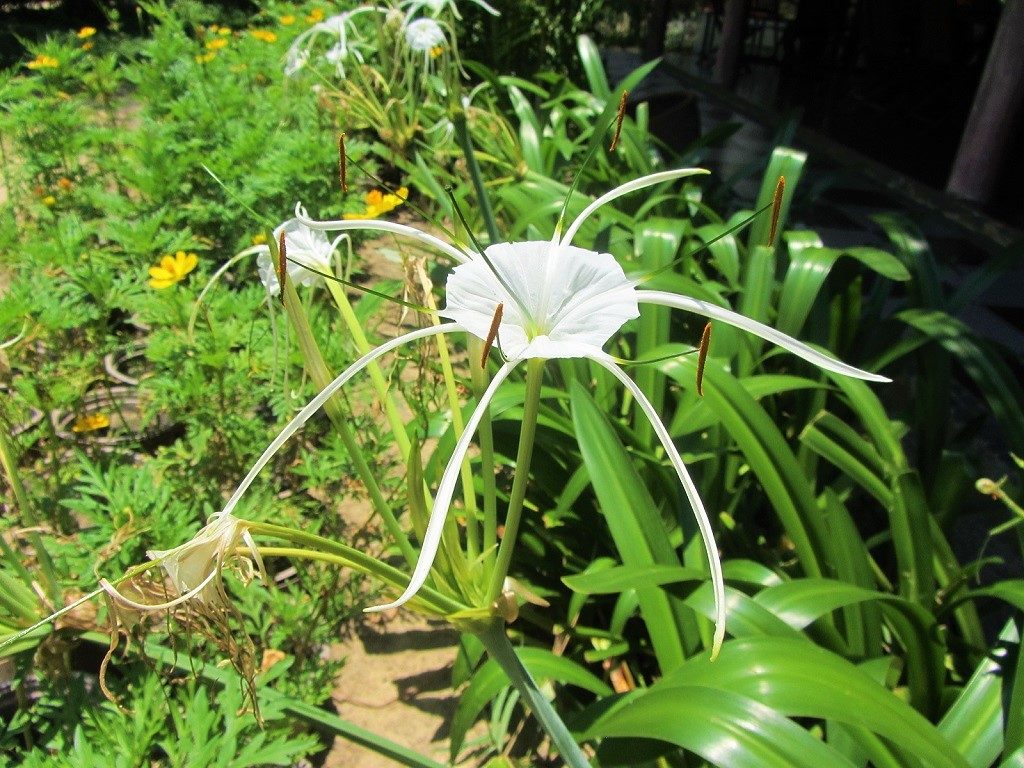
Angel’s Trumpet:
*Other names: Datura
*Where & when you might see it: Highlands & coastal regions [MAP]
A remarkable flower with a fittingly romantic name, Angel’s Trumpet is a kind of bush from which hang dozens of large, colourful, tubular flowers. A bush in full bloom is an extravagant sight. It’s not unusual to see Angel’s Trumpets exhibiting their showy flowers in the Central Highlands, particularly during the southern dry season. Some of the more prolific bushes can display over fifty flowers at one time, creating a curtain of blooming ‘trumpets’. Tapering toward the stem and fanning out near the tip, it’s easy to see how they got their name. I’m told that there are several distinct kinds of similar-looking bushes. But for the layman, like me, Angel’s Trumpet is the only name I need.


Yellow Mimosa:
*Other names: Acacia | Cây Keo Bạc (Vietnamese)
*Where & when you might see it: Central Highlands [MAP]
A medium-sized tree with small leaves that turn a distinctive silver-grey in the sunlight, and bright yellow flowers which grow in clusters along the branches, Mimosa is found mostly in Vietnam’s Central Highlands. The popular mountain city of Dalat, for example, is dotted with Mimosa trees, where its pretty appearance has romantic associations: many a hotel, cafe, and park are named after it. When the flowers are in full bloom and in the bright sunlight of a good highlands’ day, the Mimosa’s leaves and flowers glow like candles. The Vietnamese name – Cây Keo Bạc – translates roughly as ‘silver glue tree’ (I think). Which, I’m guessing, is a reference both to its silvery leaves and to its sticky sap which can be used as an adhesive.
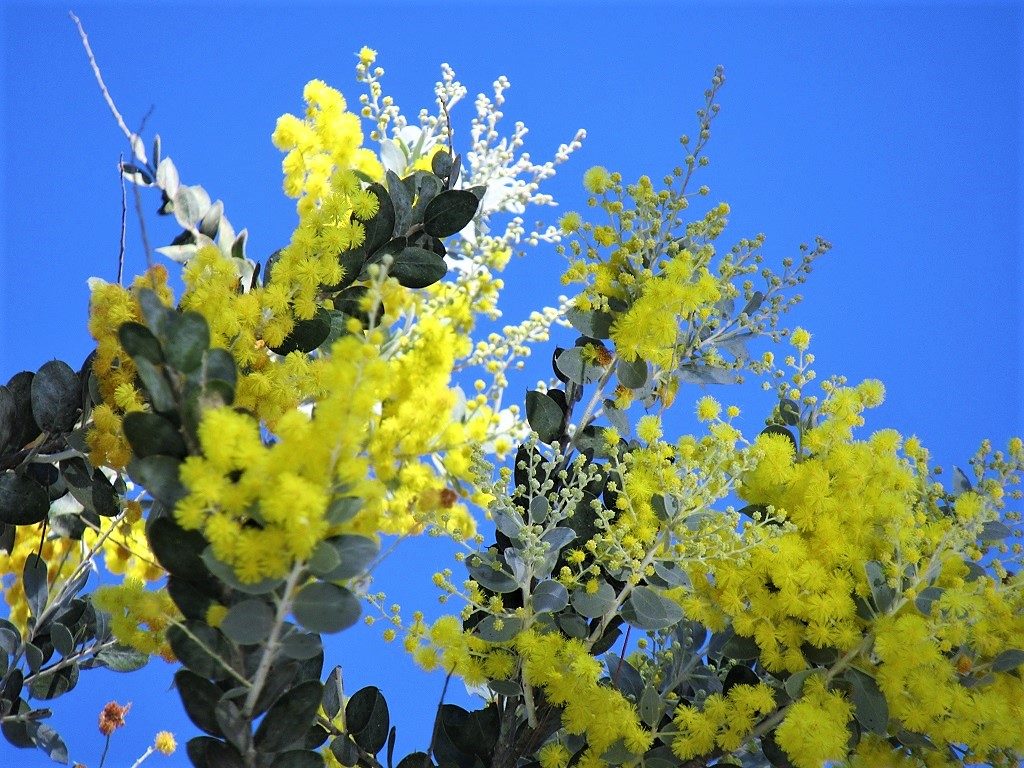

Water Lily:
*Other names: Hoa Súng (Vietnamese)
*Where & when you might see it: Mekong Delta, Coastal regions [MAP]
On the isolated tropical island of Con Son, a lake of floating water lilies lies between the mountains and the ocean. This was probably not the place where I first laid eyes on water lilies, but it is the most memorable of places I’ve seem them. The flowers have a precision and perfection that’s bewitching: somehow combining geometry and poetry. Now, I’m fortunate enough to live in a country where water lilies are not an unusual sight: indeed, when in Saigon, I have the pleasure of walking by a pond of floating lilies every day, on my way to the pool in Van Thanh Park. In Vietnam, water lilies aren’t only decorative; they’re a source of sustenance, too. Particularly, in one of the Mekong Delta’s finest and most complex noodle soups, bún mắm, the stems of water lilies – slim shoots with a purple shine – are used as a garnish, their honey-combed interior perfect for absorbing the nutritious, flavourful broth.

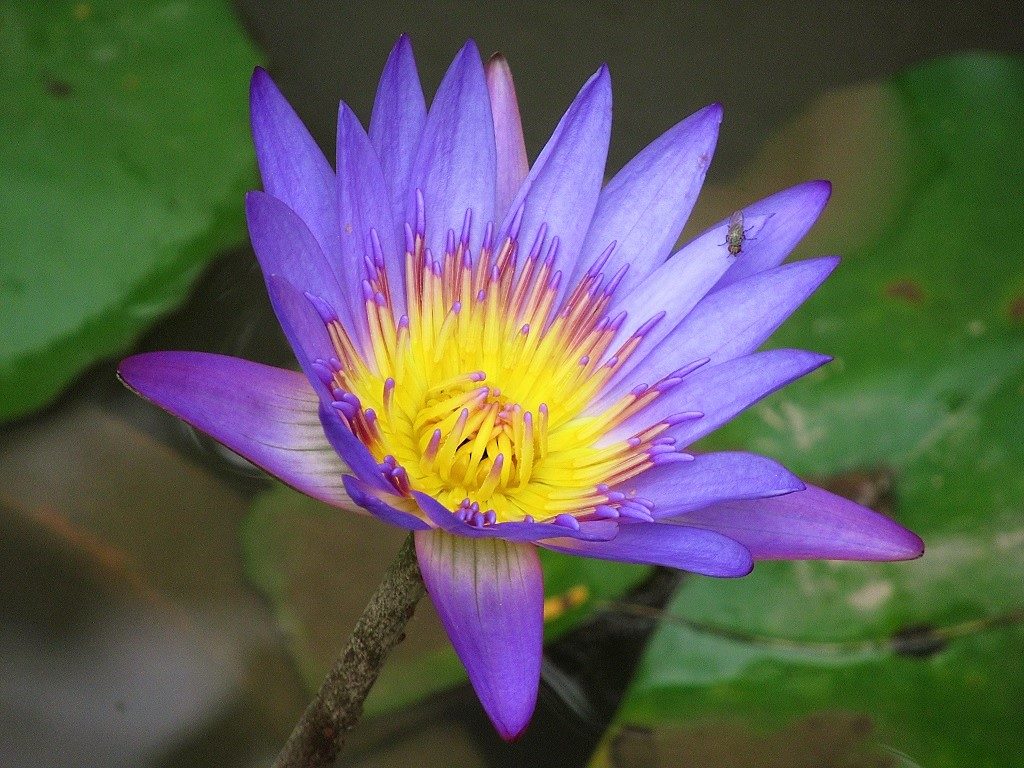
Flame Vine:
*Other names: Flaming Trumpet | Hoa chùm ớt or hoa rạng đông (Vietnamese)
*Where & when you might see it: Central Highlands [MAP]
An animated, bright and playful creeper, the Flame Vine is often seen in the Central Highlands, where it brightens even the grayest, mistiest of days. Thousands of little, tubular, bright orange or red flowers pop out from the green leaves, fraying at their tips. It’s a theatrical, showy plant.

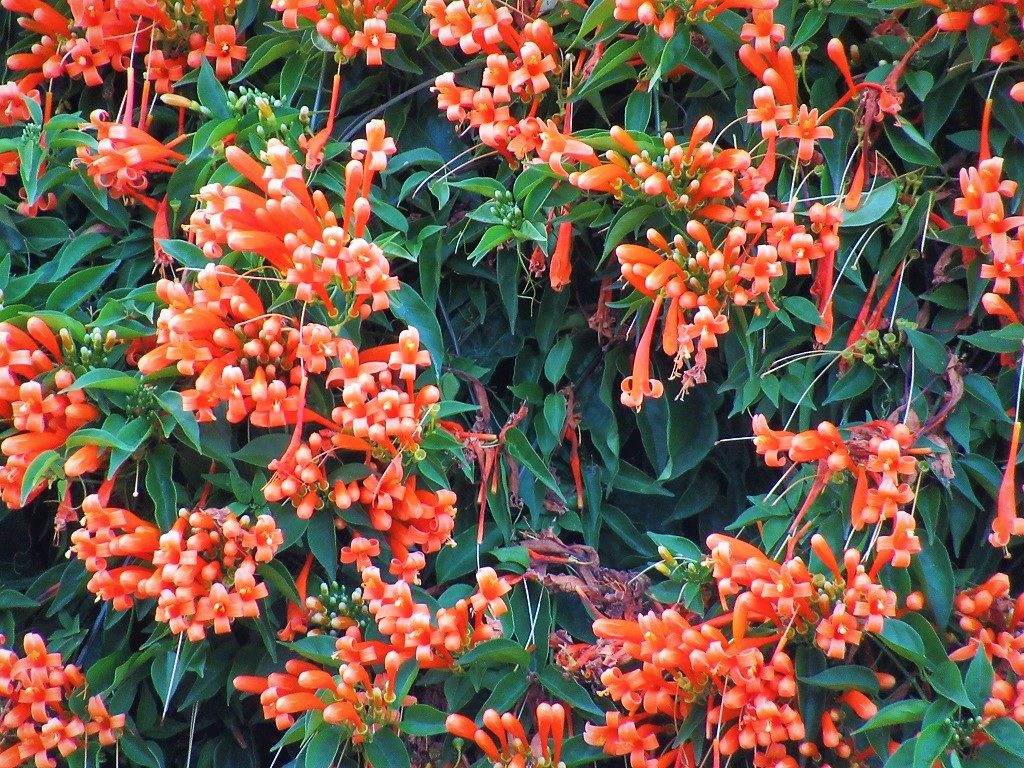
Madagascar Periwinkle:
*Other names: Dừa cạn (Vietnamese)
*Where & when you might see it: Coastal regions nationwide [MAP]
A pretty little flower with a suitably dainty name, Madagascar Periwinkles seem to grow like a weed along Vietnam’s coastline. Lining the cusp of sandy beaches, sprouting between the rocks on cliff faces, and reclaiming abandoned resort construction sites, the periwinkle appears to thrive in hot, salty, windy conditions. They’re pretty little things and easy to spot.

Yellow Oleander:
*Other names: Chi Thông Thiên (Vietnamese)
*Where & when you might see it: Coastal regions & Central Highlands [MAP]
Neat, bell-shaped flowers on a small tree with skinny, grey-green leaves, Yellow Oleander grow in gardens in the Central Highlands, or are planted as decorative vegetation along highway partitions in some southern, coastal cities. Although they’re pretty enough, Yellow Oleander are apparently toxic to animals and humans. So don’t go eating them.

Orchid Tree:
*Other names: Purple bauhinia | móng bò tím & hoa ban (Vietnamese)
*Where & when you might see it: Central Highlands & coastal regions [MAP]
I always associate the Orchid Tree with cool, clear days in Dalat, in the Central Highlands, during the dry season months of November to February. The pink-purple flowers against the clear blue highland skies seem fresh, clean and new. But Orchid Trees are also found on the tropical coast, decorating gardens and resorts. Although I’m not really a fan of orchids, the flowers of the Orchid Tree are fuller and more shapely than the potted varieties you find in nurseries, which are far too complex and showy for my taste.

Ixora:
*Other names: Jungle geranium | chi trang or cẩm tú cầu (Vietnamese)
*Where & when you might see it: Central Highlands & coastal regions [MAP]
Very neat and decorative, Ixora is a bush that I usually see growing in the Central Highlands, either by the side of the road or in gardens. The flowers grow in large clusters of one colour, but there are many varieties and many different colours: from deep red to sky blue. The flowers are so neatly presented in bunches that they look like cheerleaders’ pompoms.
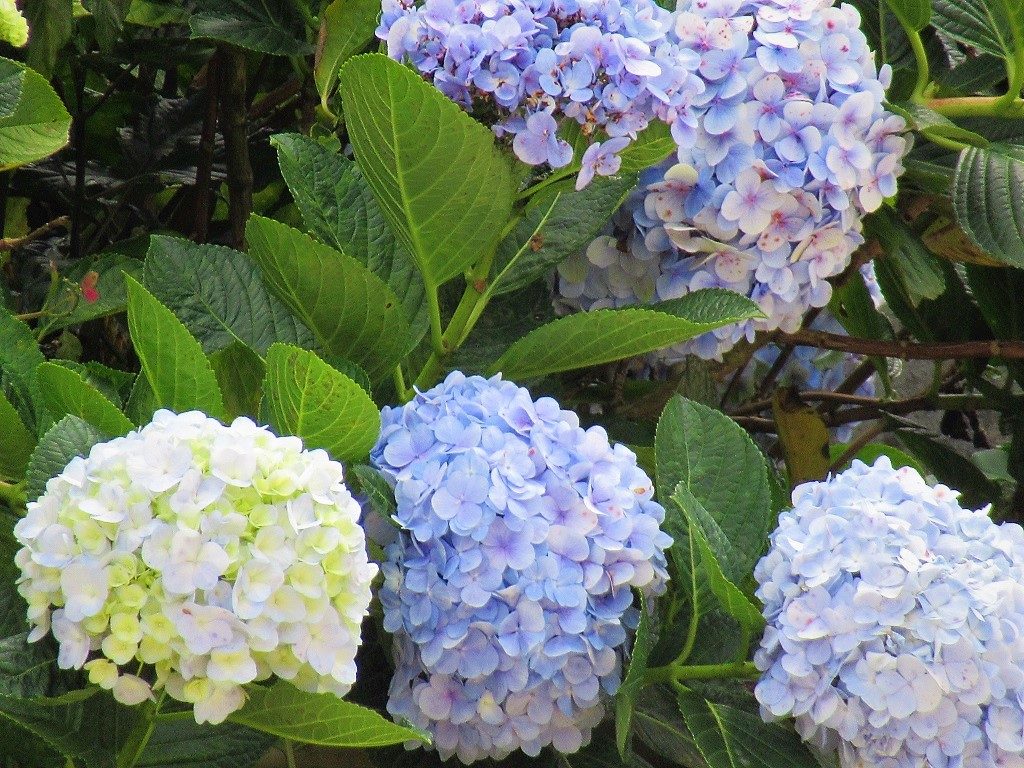
Lipstick Tree:
*Other names: Annatto | điều màu (Vietnamese)
*Where & when you might see it: Central Highlands, northern highlands [MAP]
A fairly ordinary looking bush, the Lipstick Tree is recognizable by its diamond-shaped pods, which grow in clusters of about a dozen on the thin branches. The pods turn bright red when ripe and their seeds have been used as a dye for hundreds of years. Known as annatto, the dye is red-pink. It’s used to colour food all over the world. In Vietnam, broths may contain annatto, giving them a deep red tone. The mì quảng noodle shop that I go to in Saigon, for example, has a small pan of annatto constantly on the boil in order to colour the broth. And even my home country, the UK, uses annatto: Red Leicester cheese gets its colour from the seeds of the Lipstick Tree, presumably an exotic addition made possible by the expanding trade routes of empire. Indeed, the plant’s name in Vietnamese, nhuộm, means ‘dye.

Morning Glory:
*Other names: Convolvulus | hoa rau muống (Vietnamese)
*Where & when you might see it: Coastal & river delta regions nationwide [MAP]
Growing by the beaches and rivers throughout Vietnam, Morning Glory is a common name given to this weed-like plant with pretty flowers. There are hundreds of species of convolvulus, but most of them grow by the water in horizontal vines, straddling sandy beaches, muddy riverbanks, cliffs and lakeshores. The flowers are small and delicate with a papery texture. They grow in white, pink, purple and blue. One of the most common vegetable dishes in Vietnam is rau muống xào tỏi – stir-fried morning glory in garlic. However, this is usually just one type of morning glory: the one with elongated, diamond-shaped leaves. Another common name for Morning Glory is bindweed.

Golden Shower:
*Other names: Cassia fistula | hoa hoàng yến & cây Osaka (Vietnamese)
*Where & when you might see it: Coastal & midland regions, flowering March-June [MAP]
Appropriately named, the Golden Shower tree blooms in coastal regions of Vietnam between March and June. During these months the colour is so vibrant and striking that the trees are like chandeliers of candles lining the streets. A medium-sized tree with delicate green leaves, for most of the year you don’t really notice it; only when the flowers bloom does the magic of the Golden Shower tree become clear. And it really is magic.
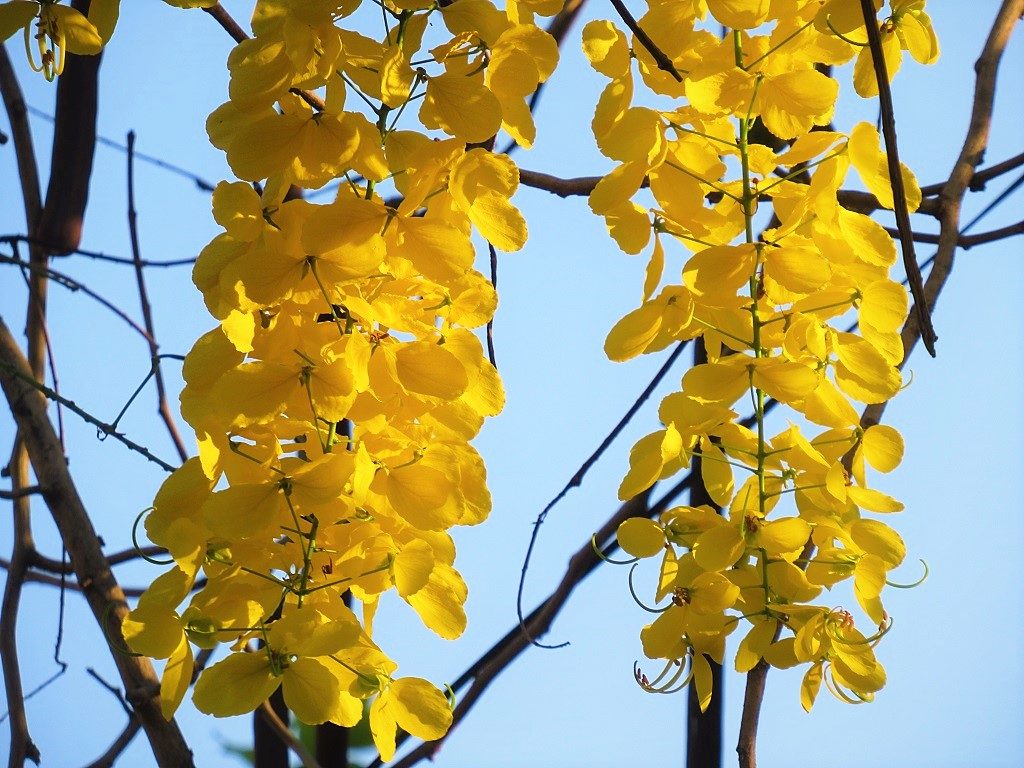

Peacock Flower:
*Other names: hoa kim phượng or hoa phượng (Vietnamese)
*Where & when you might see it: Coastal & midland regions [MAP]
Fairly common in the tropical south and central regions of Vietnam, the Peacock Flower is a shrub with small green leaves and bright red flowers with a yellow tinge, and long, protruding stamens. It grows on lowland plains, river deltas, coastal areas, and in cities. The Peacock Flower is a lively splash of colour in city parks and gardens in the bright, tropical sunshine.
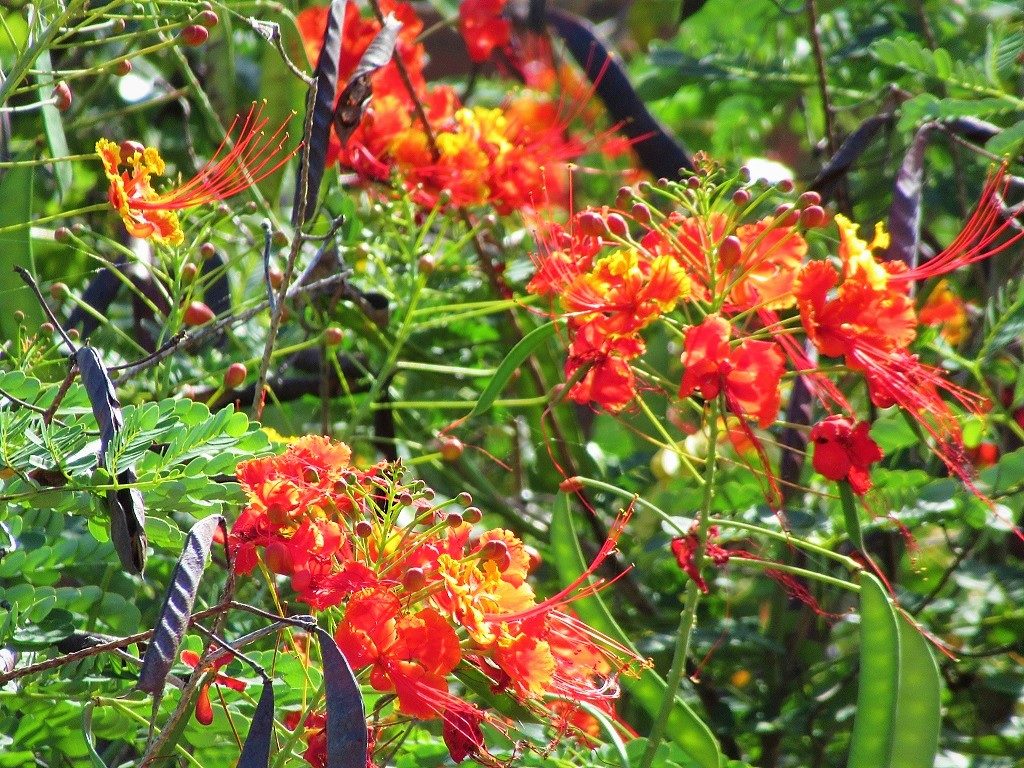
Rose Myrtle:
*Other names: Hoa sim (Vietnamese)
*Where & when you might see it: Central Highlands, forests [MAP]
A dark green bush which grows in many places in Vietnam, but particularly in the Central Highlands, the Rose Myrtle has very pretty, violet flowers. In Vietnam, the Rose Myrtle bush is most well-known for its dark berries, which are used to make a potent, flowery-flavoured liquor, called rượu sim – rose myrtle wine. You’ll find it around Dalat and on Phu Quoc Island.

Poinsettia:
*Other names: Christmas Star | hoa trạng nguyên
*Where & when you might see it: Central Highlands [MAP]
Easily recognizable by its blood-red leaves, poinsettias grow in the Central Highlands of Vietnam. Essentially a small, green tree with bursts of red leaves, Poinsettias are a fairly common sight in and around Dalat, where temperatures are around 10 degrees cooler than lowland areas. The Poinsettia is a common Christmas flower in most Western countries, which accounts for its popular name, the Christmas Star.

Heliconia:
*Other names: Lobster claws | Chi chuối pháo
*Where & when you might see it: Central Highlands & coastal regions [MAP]
A highly decorative and distinctive looking plant, Heliconia come in many varieties, all of which are very colourful. Often used in resort gardens as ornamental plants, Heliconia usually have broad, stiff, green leaves and storky stems which burst open at the tips in a cascade of colourful, beak-like flowers. The two varieties of Heliconia most commonly seen in Vietnam are pictured below: one is often called false bird-of-paradise (because of its resemblance to the birds’ ostentatious plumage), and the other is known as Lobster Claw, for obvious reasons. Both are very attractive and otherworldly: they wouldn’t look out of place on planet Pandora, in the film Avatar.

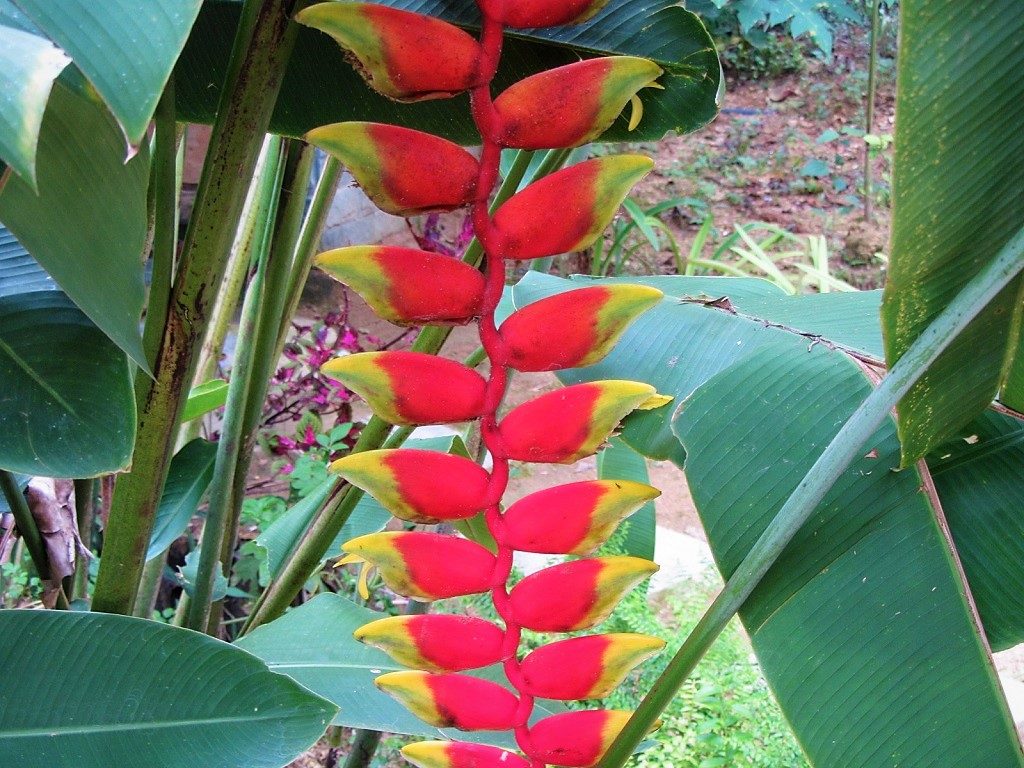
Yellow Mai Flower:
*Other names: Apricot blossom, Tet flower | Hoa mai vàng
*Where & when you might see it: Southern regions during Lunar New Year, flowering January-March [MAP]
Known primarily as the ‘Tet Flower’, the Yellow Mai is a bright, papery and pretty little bush that adorns almost every household in southern Vietnam during Lunar New Year (Tet). Yellow is the colour of prosperity, so the flower brings the promise of good fortune for the coming year. The Yellow Mai is also referred to as Apricot Blossom, but, as far as I know, this is a misnomer. The flowers are so delicate that, just a couple of days after the New Year celebrations, it starts to shed its petals, which fall to the ground creating a yellow carpet.
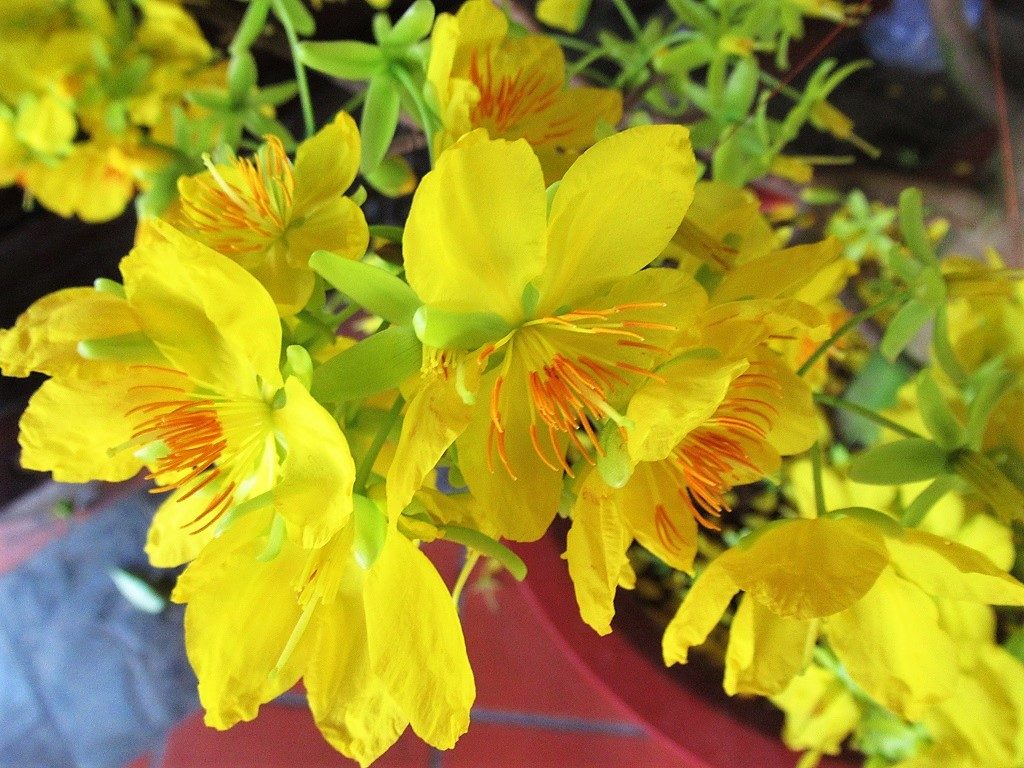

Adenium:
*Other names: Desert rose | Sứ sa mạc
*Where & when you might see it: Coastal regions [MAP]
A pink, tubular flower on a stark bush, Adenium is often found in gardens and temple grounds as a potted plant. Apparently, Adenium is related to the Frangipani, and, like the latter, its sap is highly poisonous. But you’d never guess it from its pleasing appearance.

Lotus Flower:
*Other names: Sacred Lotus | Hoa Sen (Vietnamese)
*Where & when you might see it: Freshwater ponds & lakes nationwide, particularly the Mekong Delta [MAP]
The national flower of Vietnam, the Lotus grows in freshwater ponds and lakes throughout the country. The Lotus is a sacred flower for Buddhists and Hindus alike: in Buddhist temples throughout Vietnam, Bodhisattvas and deities, such as Quan Am (the Goddess of Mercy), are portrayed standing on a lotus, hovering above the petals, or emerging from the flower. It’s not at all difficult to see how the Lotus came to be so loved and used in religious iconography: it’s a beautiful, broad flower, with pink and white petals opening and closing into a bulb with the coming and going of the day and night; the flower sits atop a delicate stem rising out of the water from wide, green pads floating on the surface. What’s more, the Lotus is also a practical flower. Every part of the Lotus is eaten or used in some way in Vietnam: the seeds, which have a wonderful, flowery flavour, are candied or used in desserts; the stems are used in soups to absorb the broth and add crunch; the roots can be sliced, battered and fried for a crunchy snack; the leaves are used to wrap and steam foods, imparting a subtle flavour, such as in lotus-steamed rice; and all parts, including the flower itself, can be used to make Lotus tea. In Saigon, I was lucky enough to live next to an urban swamp that was filled with Lotus flowers; until the water was drained and the swamp filled-in with trash and hardcore: the foundations of a future construction project. A great place to be among the Lotuses is the Mekong Delta province of Dong Thap, in the homestays on the Lotus fields.

INDEX: FRUITS & TREES
*Other names: Phượng Vĩ (Vietnamese) | Delonix Regia (Latin)
*Where & when you might see it: coastal regions throughout Vietnam; blooming from late spring to early summer: April-June [MAP]
A popular and poetic icon of Vietnam, especially in the southern and central provinces, I’ve always had a visceral response to the Flame Tree. The combination of its bright red flowers against a clear blue sky on a dry, hot day on the south-central coast moves me: an intuitive response that manifests itself in much the same way as when you hear a piece of music you love. I first learned the name in Vietnamese when wandering the great stone courtyard, gardens, and grottoes of Phat Diem Cathedral, in the northern Red River Delta province of Ninh Binh. A local man took a fallen branch and sketched the name ‘Phượng Vĩ’ in the gravel. I usually see the Flame Tree in full, glorious bloom on the south and south-central coast from late spring to early summer (April-June). But the Flame Tree is found all over Vietnam, with the possible exceptions of higher mountainous regions, such as the northwest.
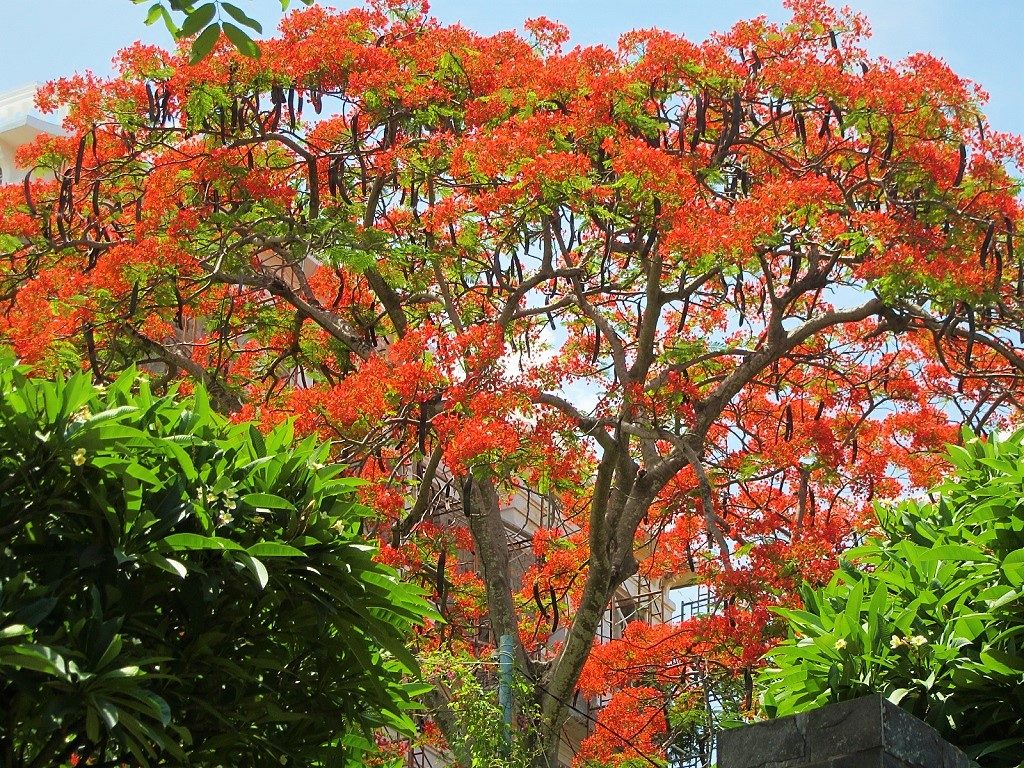
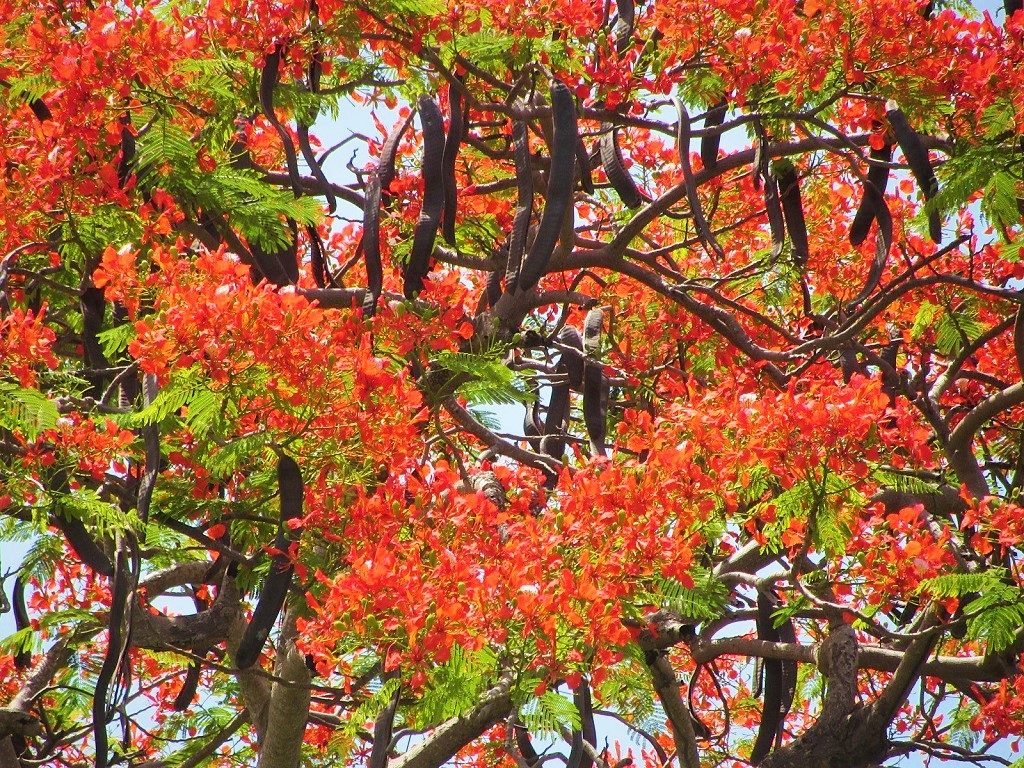
Jackfruit Tree:
*Other names: Cây mít (Vietnamese)
*Where & when you might see it: coast & midlands of south & central provinces [MAP]
One of the first fruit trees I can remember seeing regularly in Vietnam, jackfruit is a medium-sized, fairly tall and slender tree, with dark green leaves. But it’s the fruit that stands out the most. Jackfruit is an enormous, bulbous fruit with a light green, textured skin that often grows near the trunk of the tree. Weighing in at over 50kg, it’s the largest tree-borne fruit in the world. You’ll see jackfruit all over the southern and central coast and the Central Highlands, and they seem to be almost always bearing fruit. There’s a distinctive odour to jackfruit, particularly when the fruits have overripened on the tree: sweet and pungent; right on the edge of pleasant and revolting. The fruit is widely eaten in Vietnam: fresh or cooked. It’s very refreshing with a rubbery texture, or, when served in a cold salad (gỏi mít), it’s sutle, delicate, and delightful. A great, and underrated fruit.
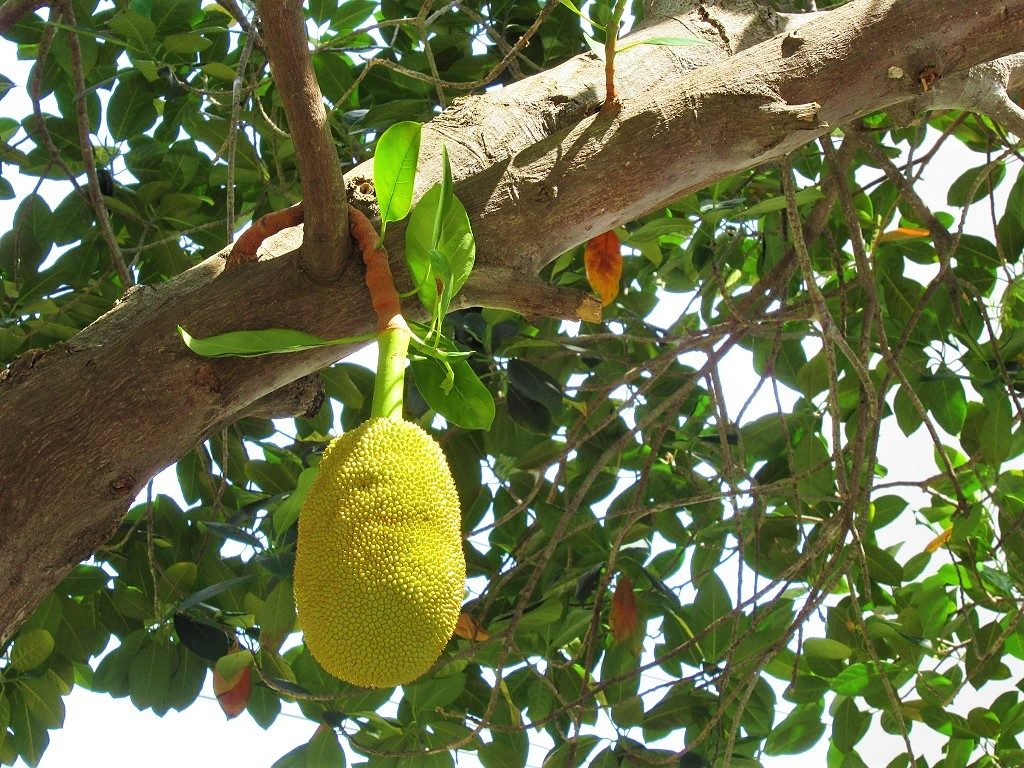
Copperpod Tree:
*Other names: Yellow Flame Tree
*Where & when you might see it: lining streets & parks in cities & towns nationwide; blooming March-April [MAP]
The copperpod is a common tree in Vietnamese towns and cities. These medium-sized trees often line main streets and boulevards, or dot parks and opens spaces. The copperpod is named after the shiny brown seedpods which hang from the branches. The trees have small, delicate leaves that grow in clusters. But it’s their yellow flowers that make copperpods most recognizable: they bloom in springtime and light up the city streets. And, when the flowers fall, they create pools of yellow on the pavements, like ‘flower shadows’. It’s a pretty sight.
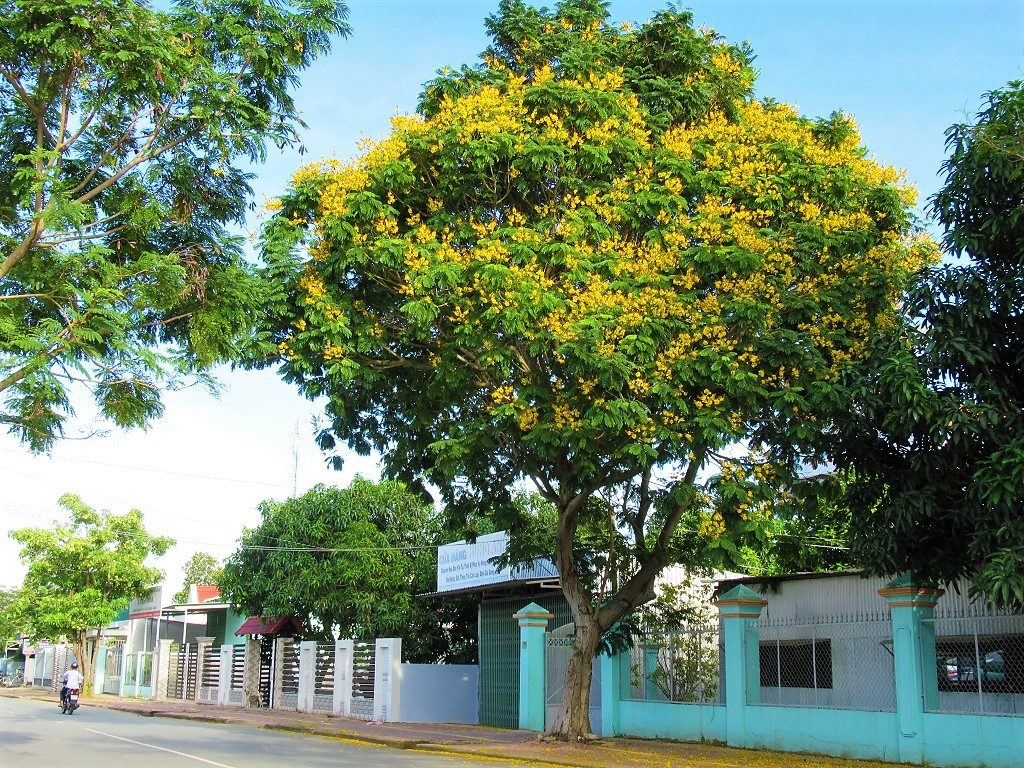

Teak Tree:
*Other names: Cây tếch | gía ty (Vietnamese)
*Where & when you might see it: in the Central Highlands & northern mountains [MAP]
The quintessential, exotic, tropical hardwood tree, teak is found in pockets throughout Vietnam’s highlands. With strikingly straight trunks – like a ship’s mast (which I presume they were used for at some point in time) – the leaves of the teak tree are very large. Teak is a valuable wood – it’s often used to make expensive furniture – so much of it has been cut down in the jungles of Vietnam. But new teak plantations can be found on the mountainsides, and older stands of teak can still be seen here and there. Like many large, old trees, there’s an atmosphere whenever you stand beneath them. Strangely, the teak trees that I’ve come across are often in eerie or significant places, such as dotting Hill A1 in Dien Bien Phu, the remote northwestern corner of Vietnam where the bloody final battle of the Franco-Vietnam war took place in 1954.
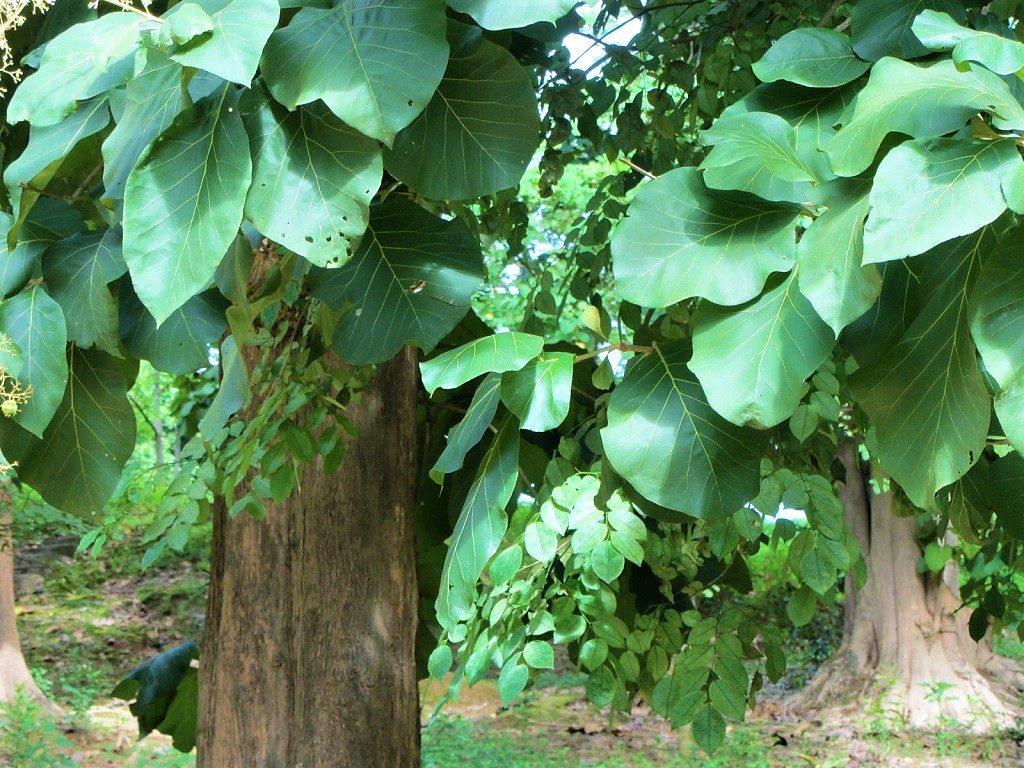
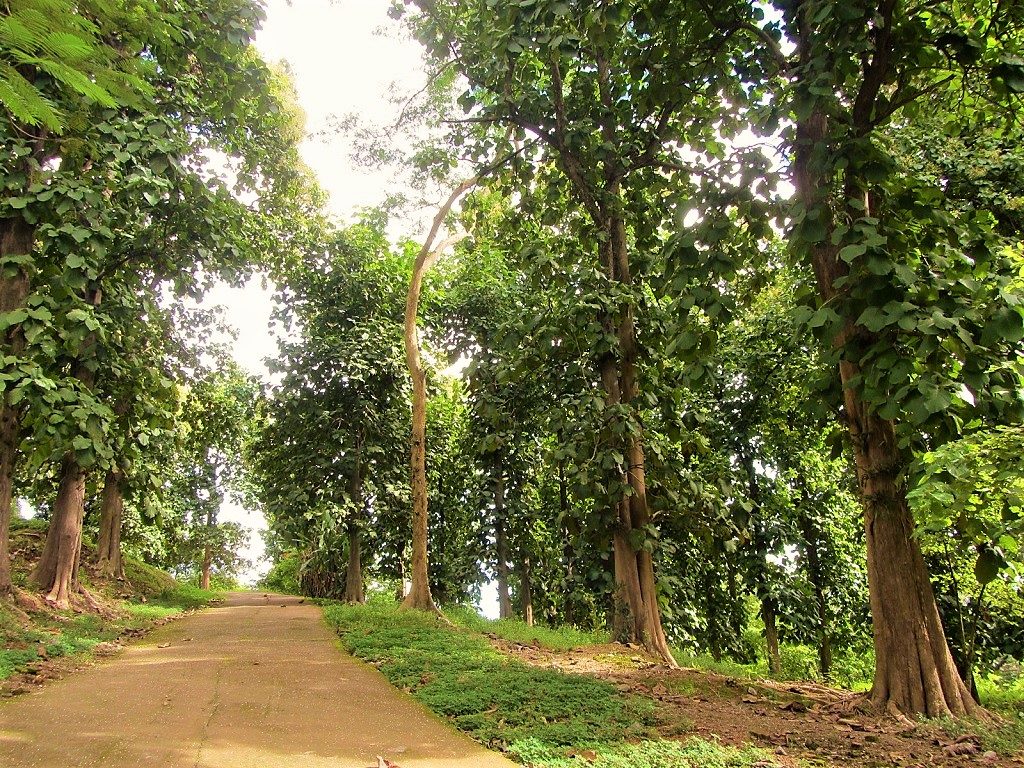
Coconut Palm:
*Other names: Cây dừa (Vietnamese)
*Where & when you might see it: all over southern and central coastal region, year-round [MAP]
The unofficial global symbol of the tropics, the coconut palm grows all over the southern and central provinces. In particular, the Mekong Delta, southern islands, and south-central coast are blanketed with these spindly palms, growing on beaches, hillsides, riverbanks, canals, and fields. You can’t not love the coconut palm. It’s somehow benevolent, calming, and reassuring: with it comes the promise of warm weather, sea breezes, salty air, tropical storms. And abundance: rarely do you see a palm without a healthy cluster of coconuts – green, brown, or red – clinging to the top of its long, tall trunk. Coconut water (nước dừa) – drank straight from the nut – is a daily drink for millions of Vietnamese. And the flesh is often made into candy (mứt dừa or kẹo dừa), among other things. Its leaves are like sails, rustling hypnotically in the wind; it’s trunks are both malleable and immovable: shaped and bent by the prevailing winds but never yielding to it.
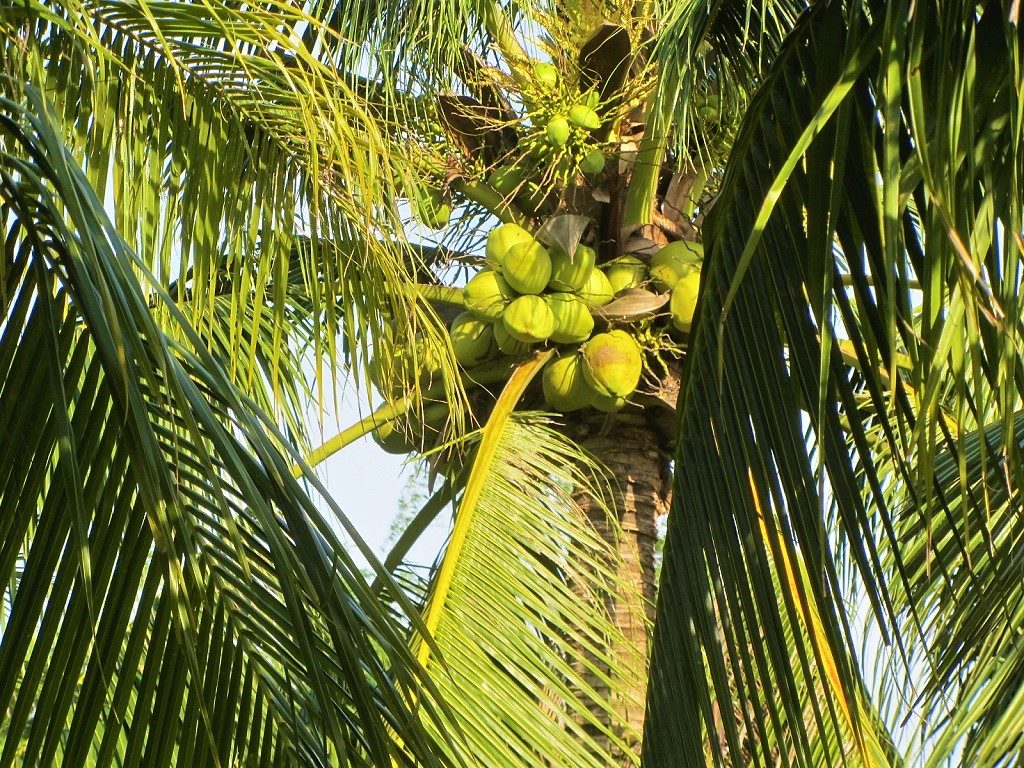
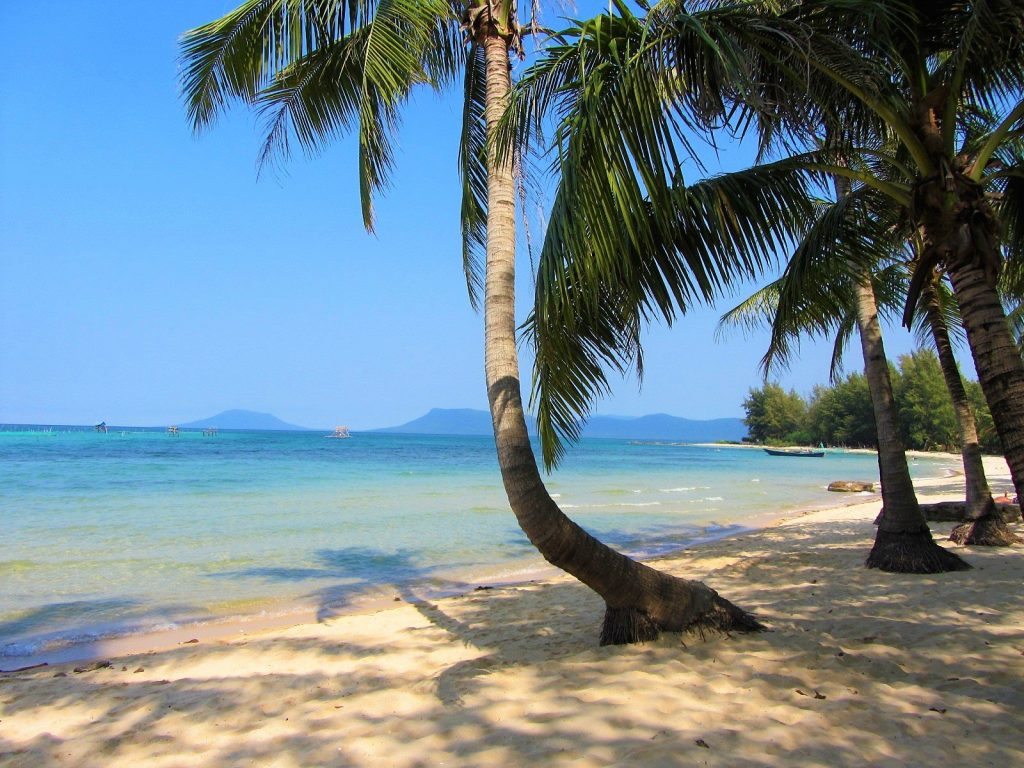
Tropical Almond Tree:
*Other names: Umbrella tree | Cây bàng (Vietnamese)
*Where & when you might see it: all coastal regions [MAP]
Seen all across coastal regions of Vietnam, the tropical almond can be a short, stocky and almost bush-like tree, or a giant, old, gnarled, grandfather tree. The leaves are shapely and thick: a satisfyingly plump heart-shape. They’re a deep green which blends with the sea and the sand of the beaches where they usually grow. But, the tropical almond is deciduous, and when the leaves fall they’re crispy and rigid, and a brilliant, shiny bronze colour. The branches tend to grow horizontally, creating a wide pool of shade beneath the canopy. This has made it popular as a shade tree throughout the world: I remember seeing an age-old local market in rural northern Ethiopia taking place in the shade of an age-old tropical almond tree. Hence another of its colloquial names: the umbrella tree. The nut is delicious when roasted. In particular, the large, century-old tropical almond trees on Con Son Island are famous for their nuts.


Indian Milkwood Pine:
*Other names: Devil tree | Cây Hoa Sữa (Vietnamese)
*Where & when you might see it: Plains, lowlands & cities; blooming in October [MAP]
A fairly ordinary looking tree, the Indian Milkwood is best-known for its white flowers, which grow in clusters and release an intoxicating aroma. Around October, you’ll catch the spicy scent of the Milkwood on an evening breeze in the cities or the countryside. The perfume transports you to an ancient spice house or herb merchant’s: cinnamon, cardamon, vanilla, cumin, clove – they’re all in there. For me, the smell encapsulates all things Asian and exotic, but some of my Vietnamese friends tell me that many people are allergic to it. Fortunately, I’m not one of them.
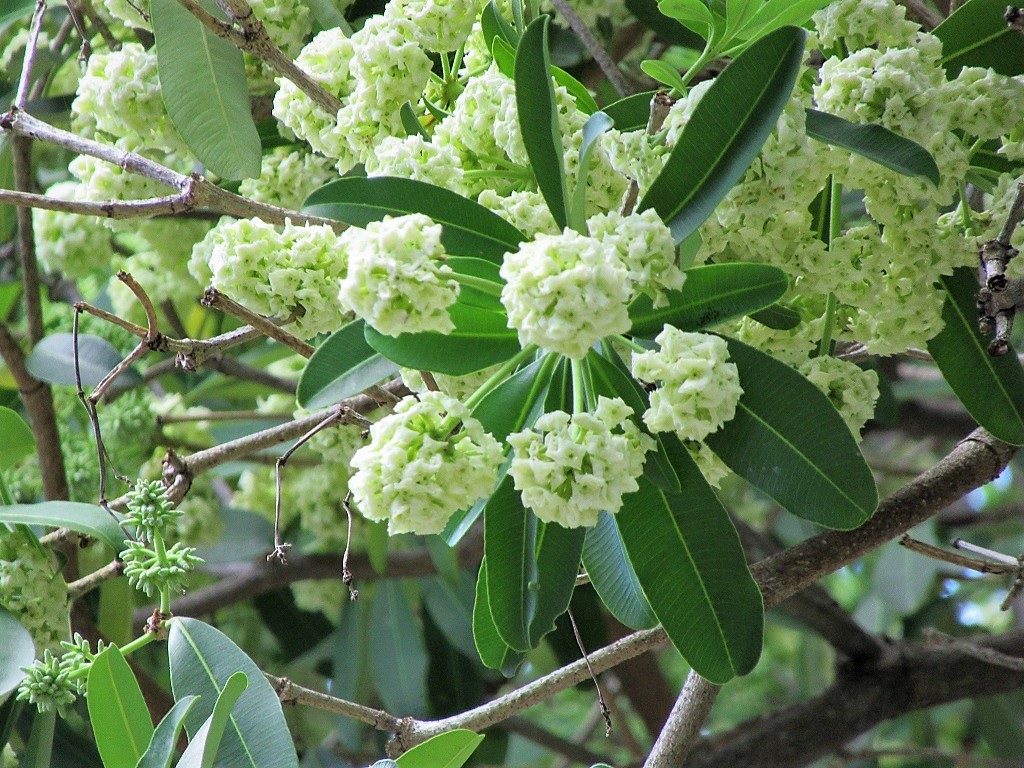
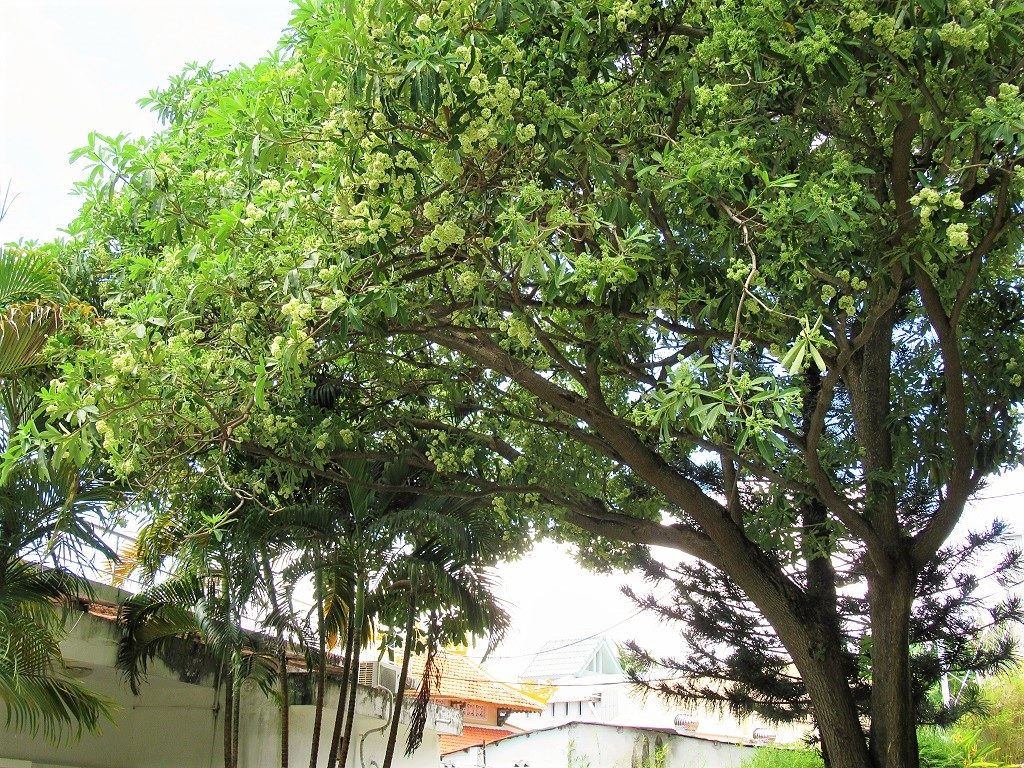
Tamarind Tree:
*Other names: Indian date | Cây me (Vietnamese)
*Where & when you might see it: Coast, lowland plains & midlands, especially southern & central regions [MAP]
I like to think the tamarind is to Vietnam what the olive is to Greece: ancient and gnarly, bearing precious fruit, and thriving in sunny, hot, arid conditions. Tamarinds can be centuries old. Many a time in the Vietnamese countryside, you’ll come across an old, stately tamarind, branches spread wide, protecting a huddled group of cattle or goats or shepherds from the blazing sun. They’ve long been used as shade trees in Vietnam. But their fruit, too, holds a special place in Vietnamese culinary culture. The copper-coloured pods reveal a sticky collection of sour-sweet seeds which can be eaten raw, or candied, or used as a flavouring for any number of delicious marinades, soups, stews and dipping sauces. It’s a special tree and there’s always an aura radiating from an old tamarind. Find one, and you’ll feel it too.
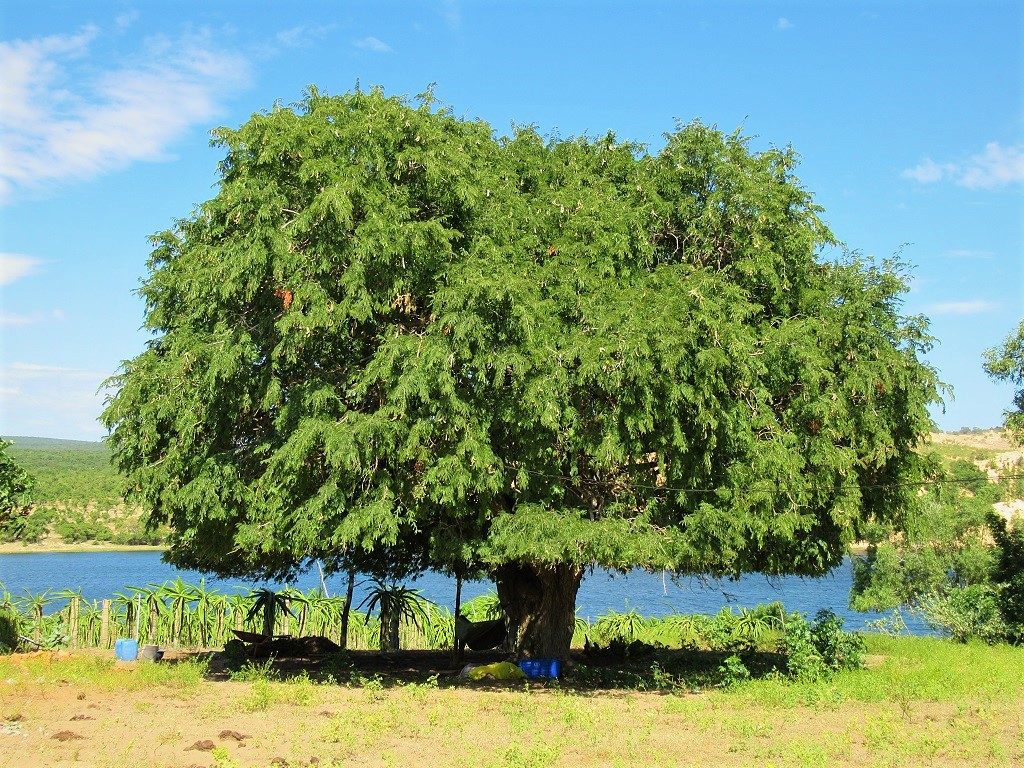

Prickly Pear Cactus:
*Other names: Xương Rồng (Vietnamese) | Opuntia (academic)
*Where & when you might see it: South-central coast & plains [MAP]
Found in the dry, arid, stark and beautiful coastal plains of the south-central provinces, the Prickly Pear Cactus is a plant that perhaps you wouldn’t expect to find in Vietnam. But in the attractive, desert-like areas of the provinces of Binh Thuan, Ninh Thuan, Khanh Hoa, Phu Yen and Binh Dinh, cactus are not an unusual sight. I don’t know much about cactus but, well, they’re green, thorny and exotic; they bear pinkish fruit (or are they flowers); and they seem to grow on rocky, sandy, windswept terrain. Apparently, there are all sorts of usages and folk stories surrounding cactus, especially in the Americas. And, in Vietnam, too, cactus are linked to myth and legend. In Vietnamese, the name for cactus – Xương Rồng – means ‘Dragon Bones’. There’s an area between Phan Rang and Ca Na, in Ninh Thuan Province, known as the Dragons’ Graveyard. It’s one of the hottest, driest places in the country. Arid and barren, but beautiful and covered in Prickly Pear Cactus, the story goes that this is where dragons came to die, and the earth scorched itself in grief.
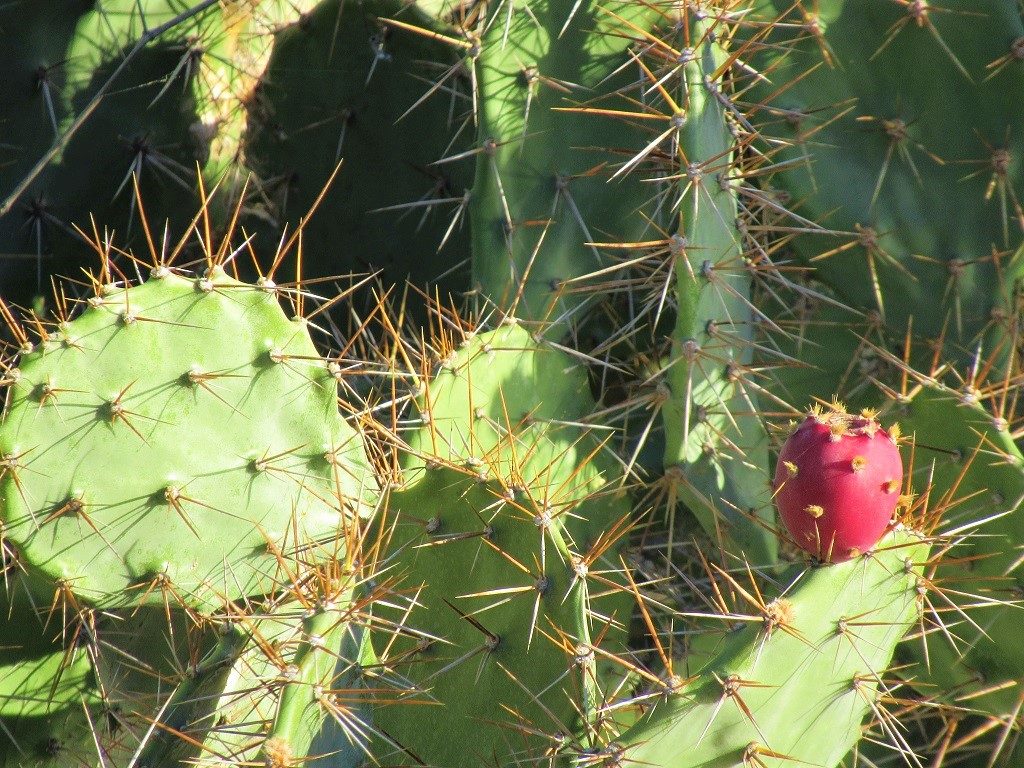

Star Apple:
*Other names: Milk Fruit | Vú Sữa (Vietnamese)
*Where & when you might see it: Coast, plains & highlands [MAP]
The Star Apple is quite a common and much-loved tropical fruit in the south of Vietnam, where it’s found along the coast, midlands and highlands. The tree is quite small and unremarkable, with thick, often crispy leaves. The fruit, however, is almost perfectly spherical; the skin glossy and smooth; the colour an attractive blend of green and purple. These’s something almost celestial about its appearance: it looks like it could be one of Jupiter’s many moons. In Vietnamese, the fruit is called vú sữa, meaning ‘breast milk’ or ‘milky breast’. This is partly to do with its shapely form from the outside, but more to do with the milky flesh on the inside. The fruit is juicy, sticky, refreshing, slightly unctuous, rich and delicious – everything that a tropical fruit should be.
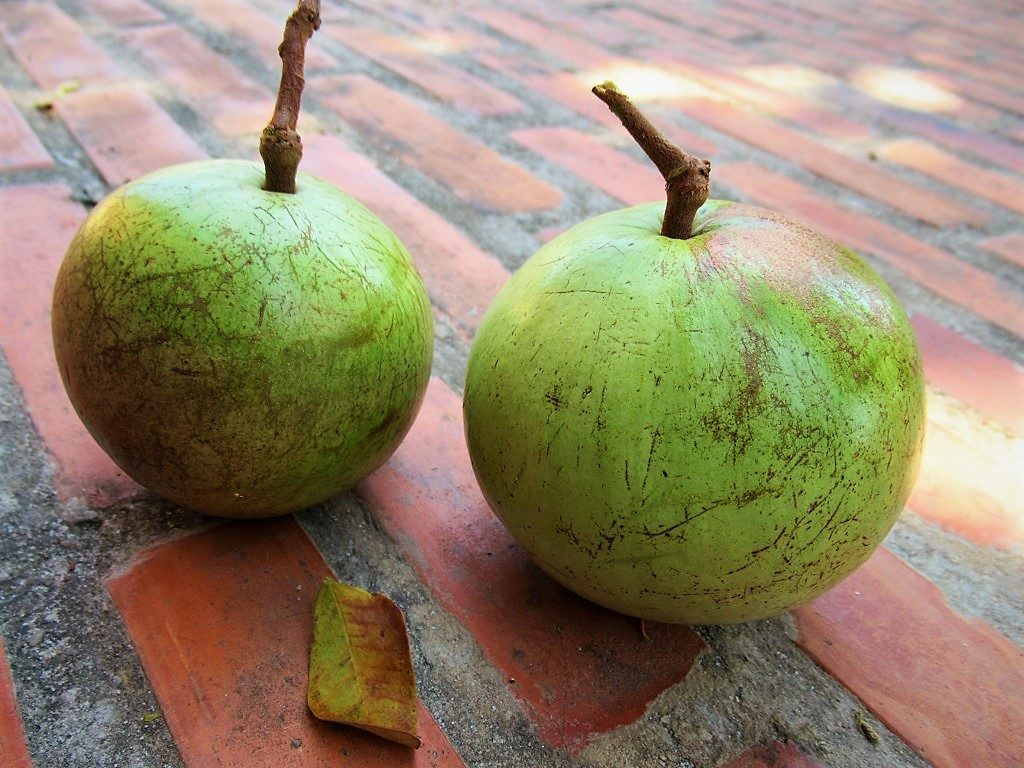

Kapok Tree:
*Other names: Silk Cotton Tree | Cây Gòn (Vietnamese)
*Where & when you might see it: Southern & central plains & coast [MAP]
When I first saw a Kapok, I thought it very striking. A fairly large tree with buttressed roots, the canopy is sparse, but the branches are laden with long, gourd-shaped seedpods. In season, the pods – hundreds of them – burst open to reveal a cotton-like material. The ‘cotton’ is harvested and used for making bedding, insulating homes, and spinning clothes, among other things. A Kapok Tree in full bloom, covered in silvery ‘hair’, is a surreal sight to behold. In Vietnam, I generally see Kapoks in midland regions – between the coast, the plains, and the mountains. Kapoks, while striking, are not especially beautiful. Perhaps this is why they often appear to be associated with the devil or evil spirits in folklore. I read a Vietnamese proverb once (although I can’t find it anywhere now, and no one else seems to have heard it) that goes: Đền cây đa, ma cây gòn: The spirits live in the Banyan tree, the ghosts in the Kapok.


Papaya Tree:
*Other names: Pawpaw | Cây Đu Đủ (Vietnamese)
*Where & when you might see it: Coast, plains & highlands nationwide [MAP]
A slender tree with a burst of star-shaped leaves at the top, the Papaya looks a bit like a composite of a coconut palm and a fig tree. Clinging to its spindly trunk are clusters of bulging, breast-shaped fruit. To me, the Papaya is a quintessentially exotic, tropical fruit. Colourful, perfumed, juicy, and full of little black seeds, it’s been a staple of my breakfast in Vietnam for years. Papaya trees grow in abundance all over the country: I’ve seen them in the cool highlands, the hot, arid plains, and they’re prolific on the tropical coast, especially in the southern provinces. Papaya is used in dozens of Vietnamese dishes. Several salads use green, unripe papaya for crunch, texture, and colour; and the fruit is used for refreshing smoothies and sweet desserts. Papaya is also supposed to be very healthy.
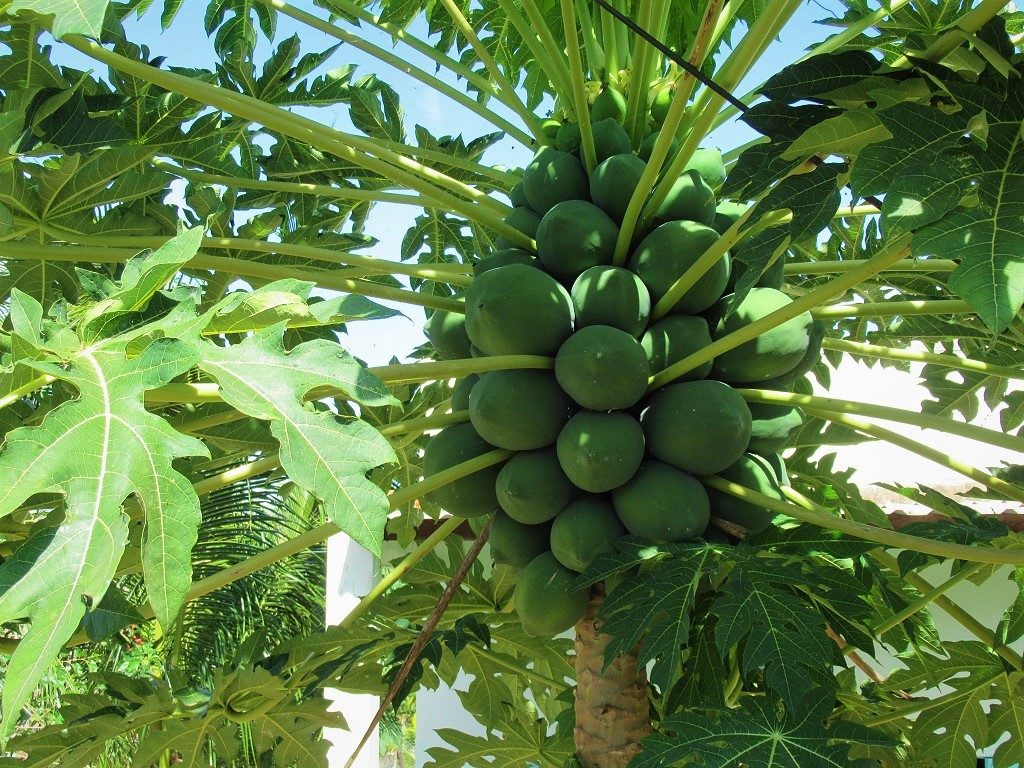
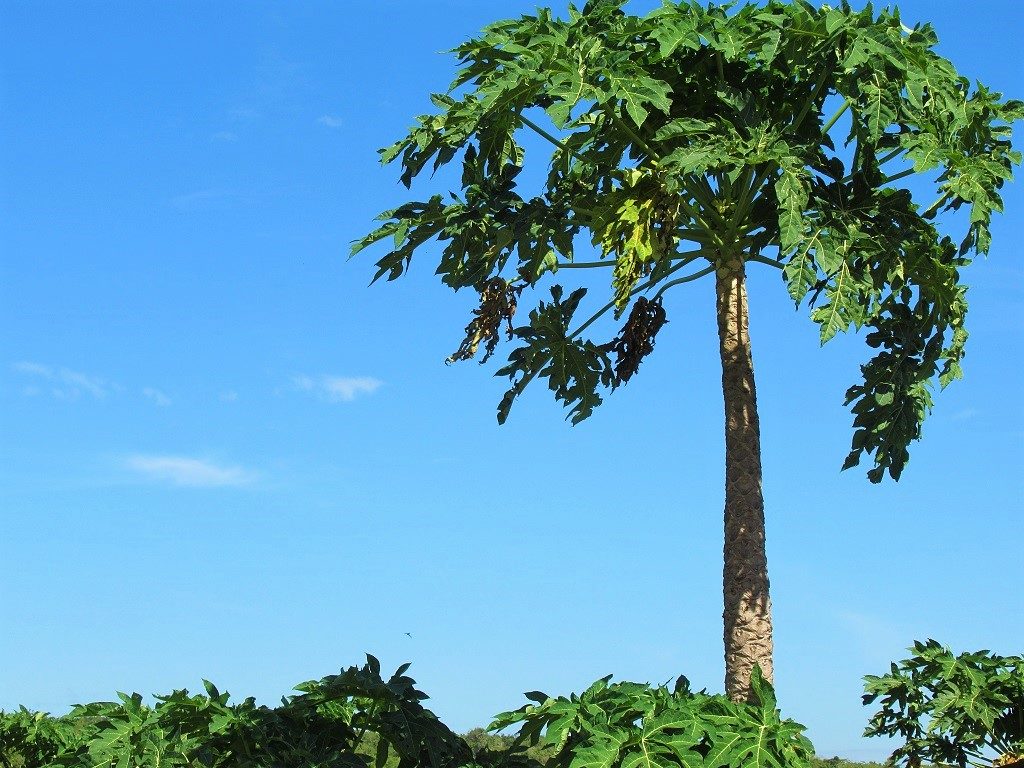
Traveller’s Palm:
*Other names: Ravenala | Chuối Quạt (Vietnamese)
*Where & when you might see it: Coastal & delta regions nationwide [MAP]
Exotic and almost prehistoric in appearance, I can easily imagine the Traveller’s Palm dotting the landscapes in which dinosaurs used to roam. Apparently originating from Madagascar, the Traveller’s Palm is a favourite decorative tree in Vietnam. From resorts to villas to compounds to farmhouses, the elaborate fan of the Traveller’s Palm’s green sails adorns and enlivens many an urban and rural scene. The leaves resemble that of the banana plant, and the Vietnamese name – chuối quạt – means ‘banana fan’. Its English name is a good story: The long, grooved stems of this tree bring rainwater down from the leaves to the trunk. So effective are they at catching and storing rainwater, that there’s almost always a reservoir of water at the base of the stems. Thirsty travellers can always rely on a fresh water supply whenever these trees are around: hence the name, Traveller’s Palm. If I ever have a garden of my own in Vietnam, I’d want a couple of Traveller’s Palms in it. Apart from their distinctive and attractive appearance, I find there’s something comforting about them.

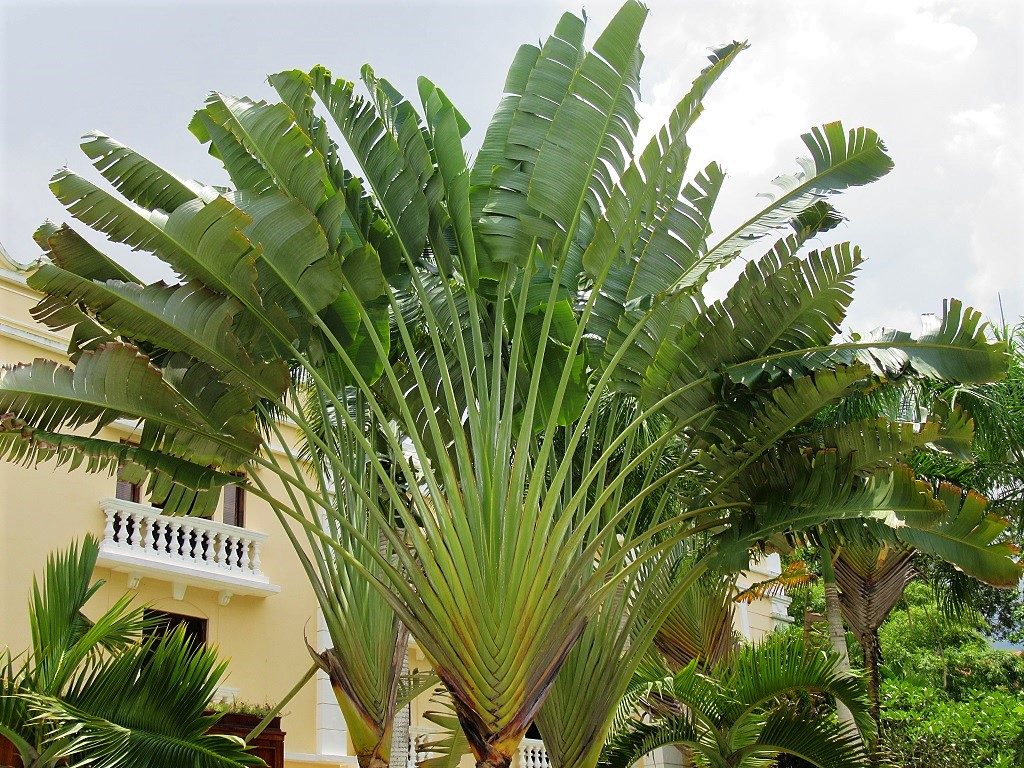
Persimmon Tree:
*Other names: Qủa Hồng (Vietnamese)
*Where & when you might see it: Central Highlands [MAP]
I always associate persimmons with autumnal weather. This is because I usually see the spindly trees in the cool, crisp air of the Central Highlands, around Dalat, in the months November to February, when they bear fruit. Hanging like decorative balls on a Christmas tree, persimmons are large, shapely, orange-red fruit, which are eaten raw or dried, squashed and candied. The latter is an excellent accompaniment to hot green tea in the cool highland climate. Personally, I’ve only seen persimmon trees in the Central Highlands, but I imagine they grow in the north, too, during the cold winters.
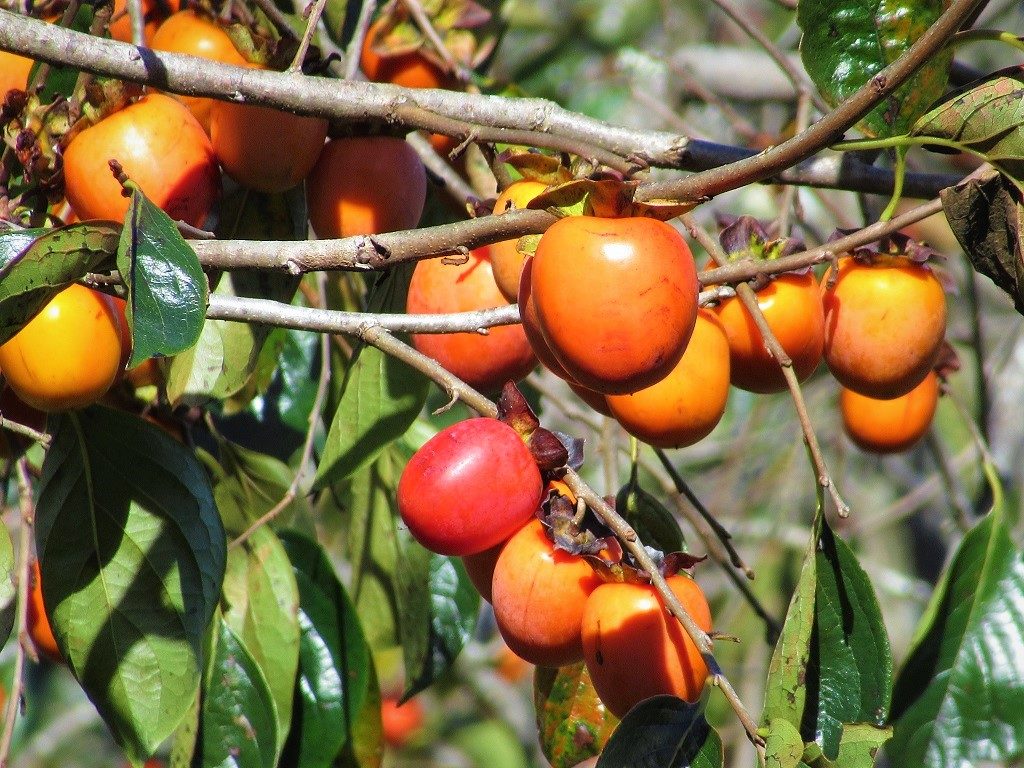
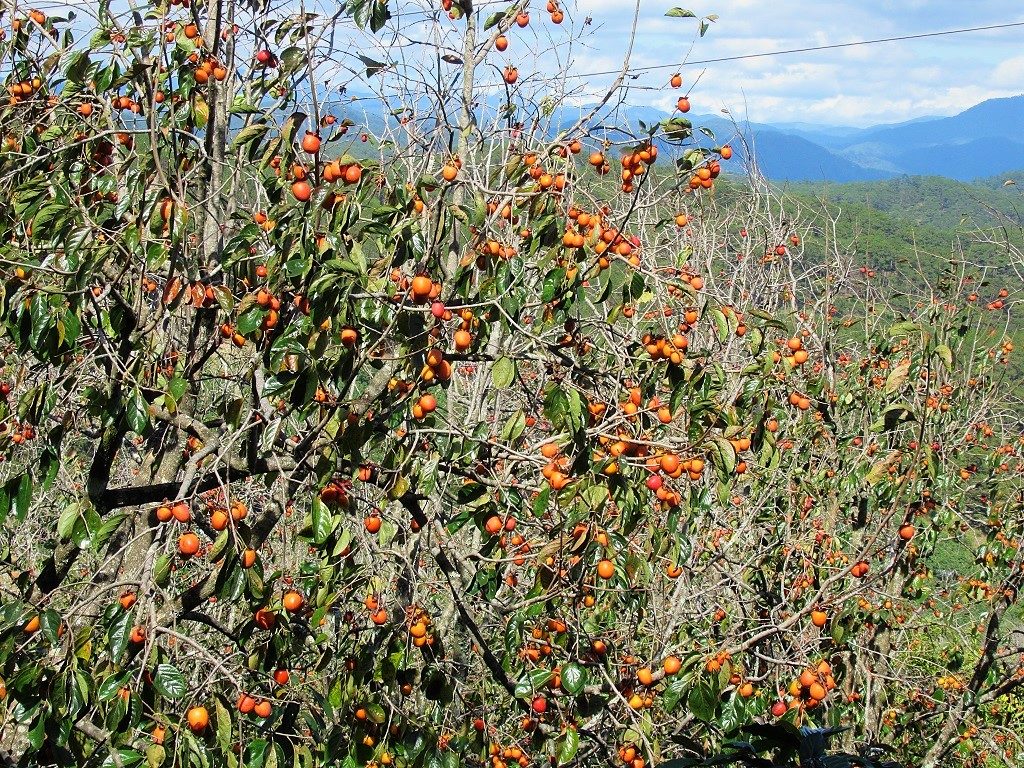
Grape Vine:
*Other names: Vitis | Chi Nho (Vietnamese)
*Where & when you might see it: Central coastal plains [MAP]
The main grape growing region in Vietnam is along the arid coast and dry, inland plains of Ninh Thuan, a south-central province. Ninh Thuan has a strikingly stark and non-tropical landscape – indeed, it looks more like southern Spain than Southeast Asia. So it seems fitting that this is where Vietnam’s grapes are grown. The vines are wound around wooden trellises, growing about 5-feet above ground. Introduced by the colonial French in the 19th and 20th centuries, Vietnam continues to grow grapes for wine production, honey, raisins and candies. Despite the grapes being grown in Ninh Thuan, the wine they produce is generally called Dalat Wine. I’m not a connoisseur, but it doesn’t taste great to me. However, the grapes themselves are delicious, as is the honey, the raisins and the fruit. If you ride along the scenic Nui Chua Coast Road in Ninh Thuan Province, you’ll see signs for grape farms where you can buy all grape products: look for vườn nho.
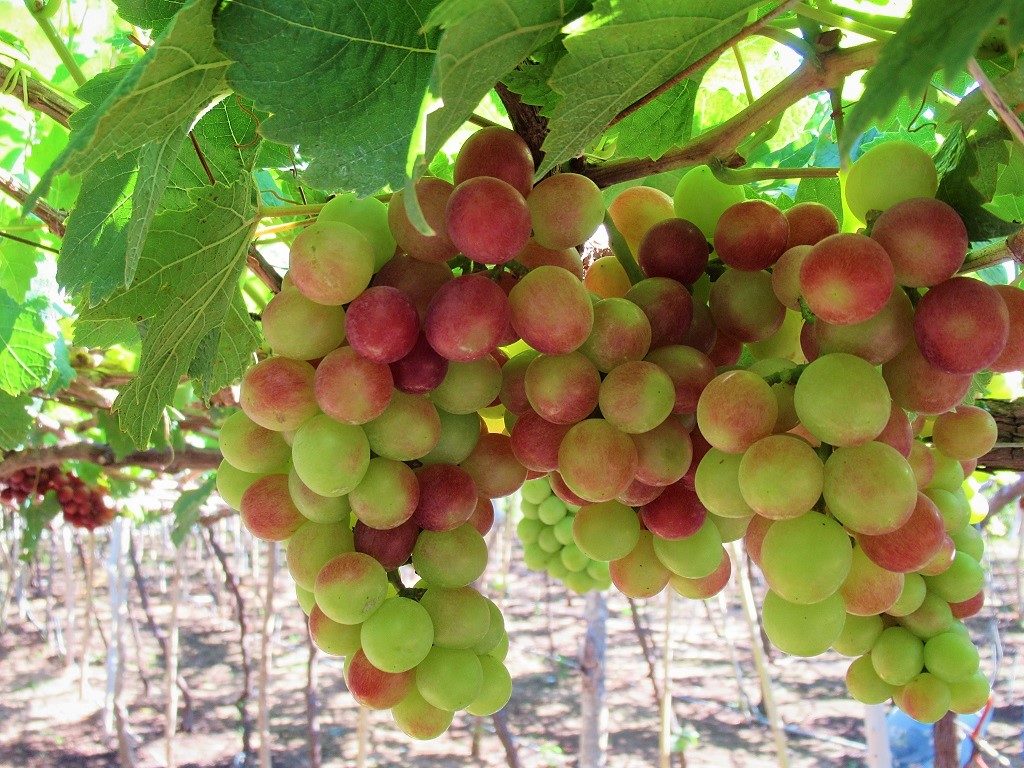
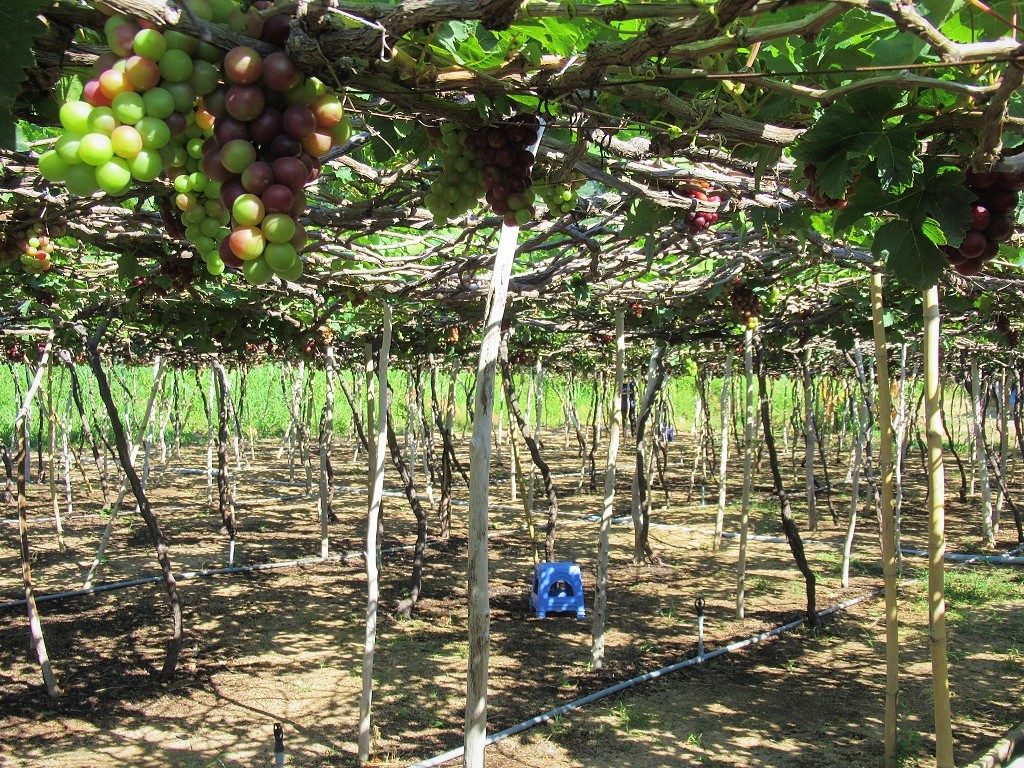
Casuarina Tree:
*Other names: Cây Phi Lao (Vietnamese)
*Where & when you might see it: Coastal regions nationwide [MAP]
All along Vietnam’s long and meandering coastline are found large stands of Casuarina trees. An evergreen, pine-like tree with a flaky bark and slender green-grey needles, the Casuarina was one of the first trees whose names I learned while in Vietnam. That was on my first trips to the southeastern coast, where Casuarinas grow in the brackish water between the beach and the ocean. They’re tall, whispering trees with a silver glow when wet after a tropical shower. Handsome, strong, and ‘friendly’ trees, there’s also something mildly haunting about Casuarinas: perhaps it’s their ghost-like pallor and the diaphanous quality of their canopy. Over the years, it’s been sad to see many thousands of Casuarinas along Vietnam’s coast being cut down to make way for multi-storey resort complexes. These were trees that, being native to Southeast Asia and the Indian subcontinent, had grown there for centuries, greeting all who came and went on the beaches over generations. In some exceptional and admiral cases, resorts have chosen to build around the trees, incorporating them into the design, such as at Ho Tram Beach Boutique.
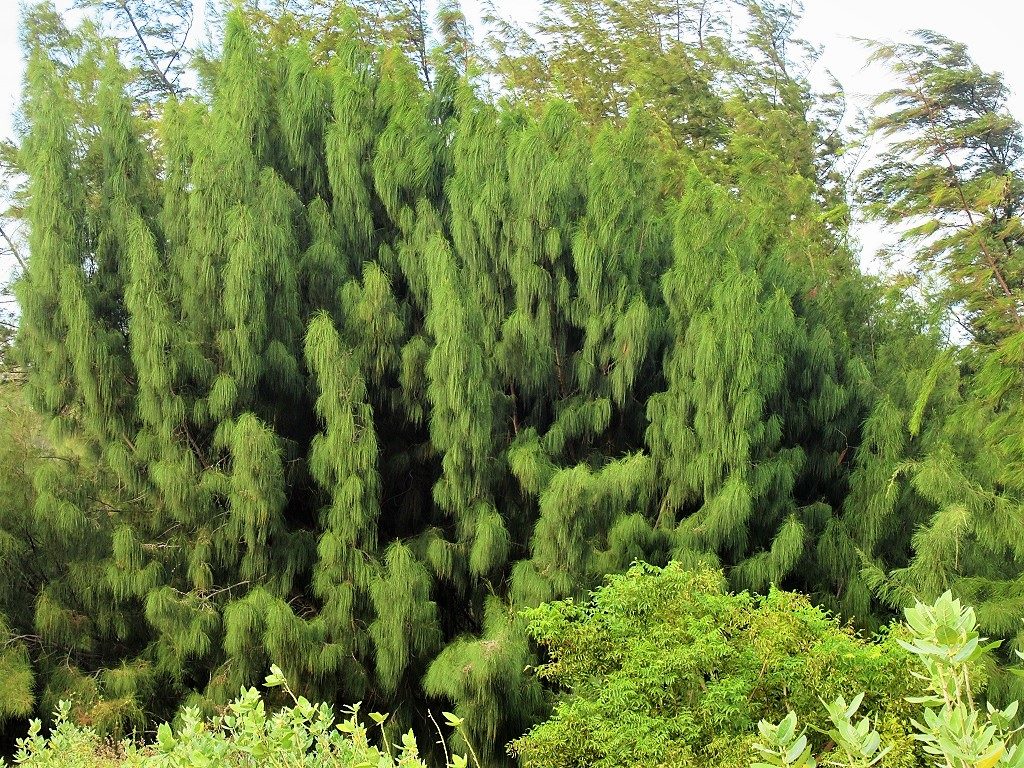
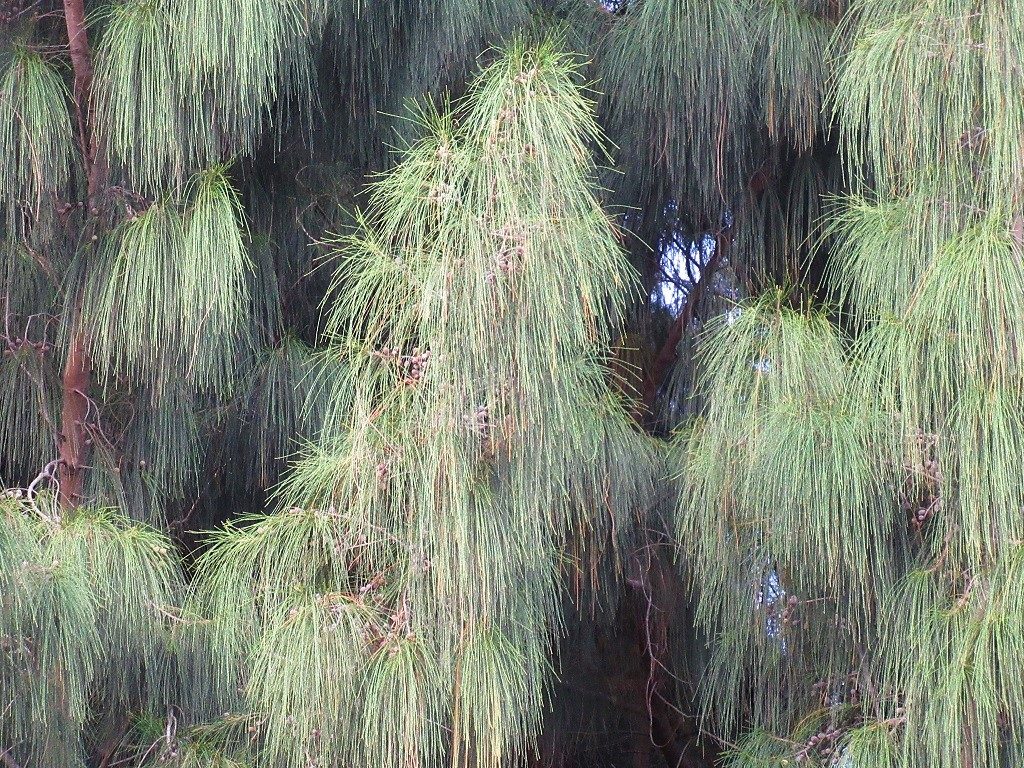
Dragon Fruit Tree:
*Other names: Pitaya | Thanh Long (Vietnamese)
*Where & when you might see it: South-central coast [MAP]
Often seen in dry southern coastal regions, Dragon Fruit is famous as one of the most exotic-looking and colourful tropical fruits. One area in particular is known for it: Binh Thuan, sometimes referred to as Dragon Fruit Province. The fruit is bright pink with green tips at the end of several flame-like ‘fins’. Inside, the flesh is white (or red or purple in some cases) with little black seeds. The fruit is refreshing and watery but surprisingly tasteless. Peeling the fruit is half the fun: the skin is thick and waxy, and comes off in a satisfying way. The Dragon Fruit tree is a kind of cactus, growing in slim, spiky shoots. In Vietnam, several strands of the cactus are grafted to a concrete post and encouraged to grow up the pillar. At night, the plantations are illuminated by naked light bulbs, resulting in a patchwork of yellow-glowing fields in the blackness, like the scene of a UFO landing site in the X-Files. Dragon Fruit trees are a strange and distinctive arrangement that remind me of Sideshow Bob’s hair-do in the Simpsons. The trees look very dramatic when bearing fruit, and they also have an impressive white flower. You’ll see lots of Dragon Fruit plantations on the Ocean Road between Saigon and Mui Ne.
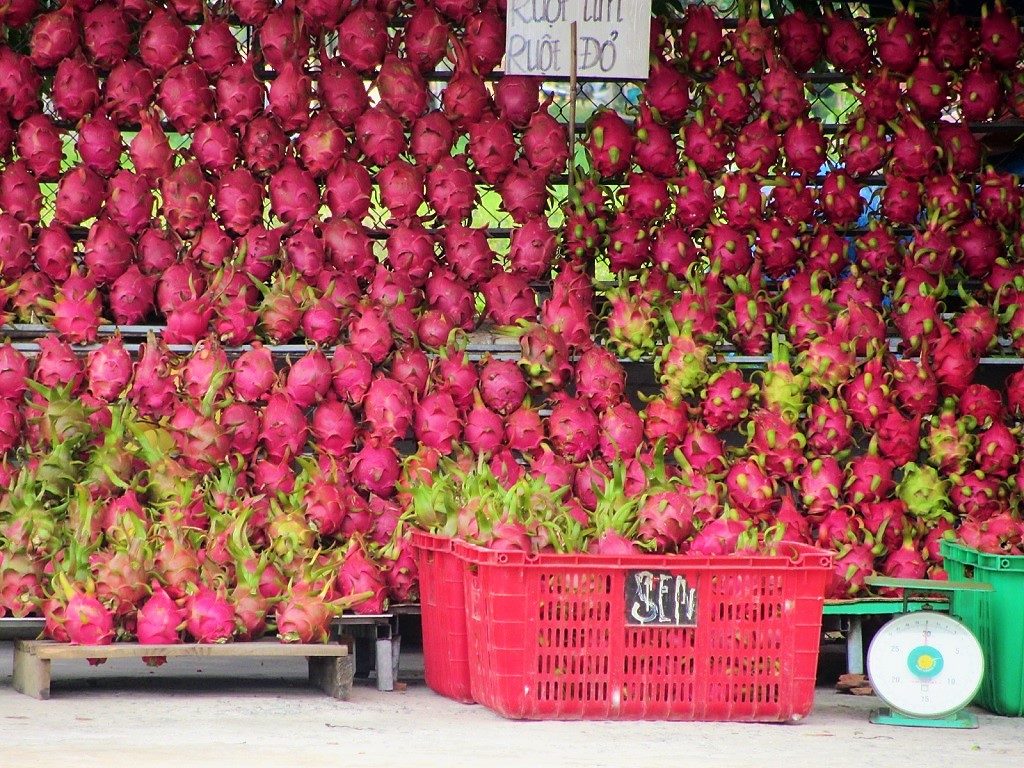

Chilli Pepper:
*Other names: Ớt (Vietnamese)
*Where & when you might see it: South & central coast [MAP]
Red chillies are added to many dishes in Vietnamese cuisine: either in the cooking process or as a condiment. In general, the most commonly used and grown chillies in Vietnam as small, red peppers, sometimes no bigger than a fingernail. These are very spicy but also have a wonderful, flowery aroma. Indeed, I enjoy the smell of red chillies more than the flavour. Most of the chillies I see in Vietnam are grown in the hotter, drier regions, such as the south and central coast. The chilli plants are small and delicate, with the little red peppers dotted all over the bush like drops of blood.
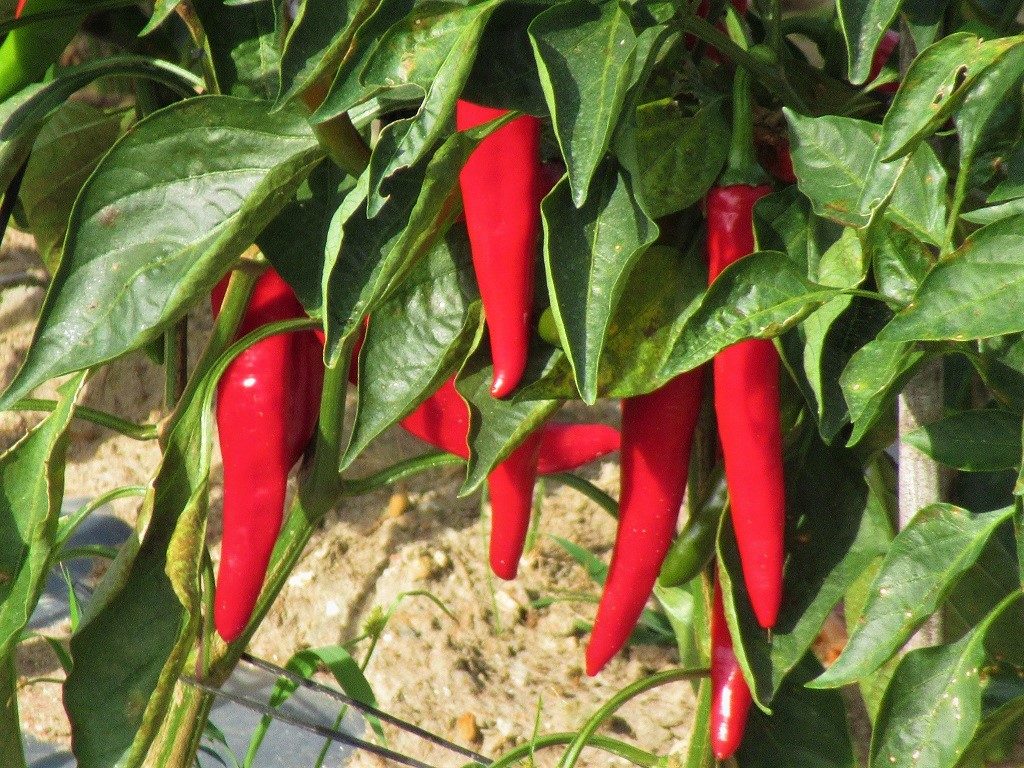
Banyan Tree:
*Other names: Strangler fig | Cây Đa (Vietnamese)
*Where & when you might see it: Jungle & forest regions nationwide [MAP]
To my mind, the king of trees in Asia, the Banyan is grand, exotic, heroic, mysterious and majestic. But it also has a dark side. Certain Banyan trees in Vietnam are worshiped – either for the tree spirits that are said to dwell in them or for historic events which took place beneath their great, splayed branches. It’s not difficult to understand how the Banyan became sacred: its size, beauty and majesty exude presence and a noble, timeless aura. They are the cathedrals of the forest. Banyans can grow to enormous sizes and live many centuries, sometimes over a thousand years. A saying I read once (but have never heard again since) goes: Đền cây đa, ma cây gòn: The spirits live in the Banyan tree, the ghosts in the Kapok. This implies the Banyan has a benevolent nature; a sentiment I’m inclined to agree with. But the genesis of a Banyan tree is very much at odds with this image. Banyans are ‘stranglers’, meaning they feed upon a host tree by wrapping vines around its trunk and branches then sending tentacles down to the forest floor to get nutrients from the soil. Slowly, the host tree dies and, over time, rots away completely, leaving a hollow void where once the original tree stood. This is why many Banyans have impressive empty arches at their base. To me, this is a rather sinister beginning to the life of one of the world’s greatest trees. Because of their size, Banyans have been used as shade trees and meeting points in Vietnam, and elsewhere, for thousands of years. Many famous meetings and events have taken place under Banyans. Indeed, the word ‘Banyan’ is said to originate from the name of an itinerant group of traders in India, who traveled from place to place selling their wares, always setting up shop under a Banyan tree. When I travelled in northern Ethiopia, most markets in small, rural towns still set up under big, old Banyans. (A good, easily accessible place to see impressive, old Banyans in the forest is on Son Tra Peninsular).

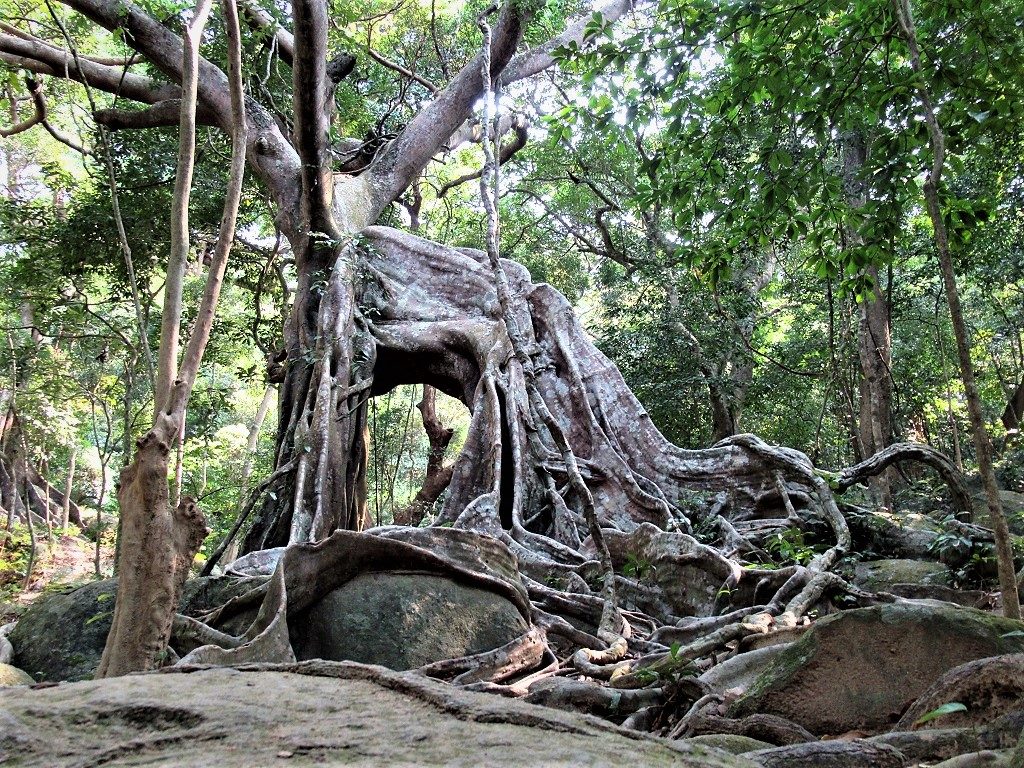

Bodhi Tree:
*Other names: Ficus religiosa, Sacred Fig | Cây Bồ Đề(Vietnamese)
*Where & when you might see it: Outside Buddhist temples nationwide [MAP]
Famous as the tree under which Siddhartha Gautama attained enlightenment and thus became the Buddha, the Bodhi Tree, which means ‘perfect knowledge’, has strong spiritual associations and is found in most temple grounds in Vietnam. Also known as the Sacred Fig, the Bodhi is recognizable by its heart-shaped leaves, its distinctive canopy which flares out horizontally, and the multiple vines which grow around its thick trunk like veins. Vietnam is one of the countries to which the Bodhi is native, and they can be found across the nation. The Bodhi is extraordinarily long-lived, sometimes exceeding 2,000 years. Bodhi trees are often planted in Buddhist temple grounds in Vietnam, or religious sanctuaries constructed around the sacred tree in situ. And, in the wild, little spirit houses are sometimes placed at the base of the trunk or in the canopy of the Bodhi Tree.
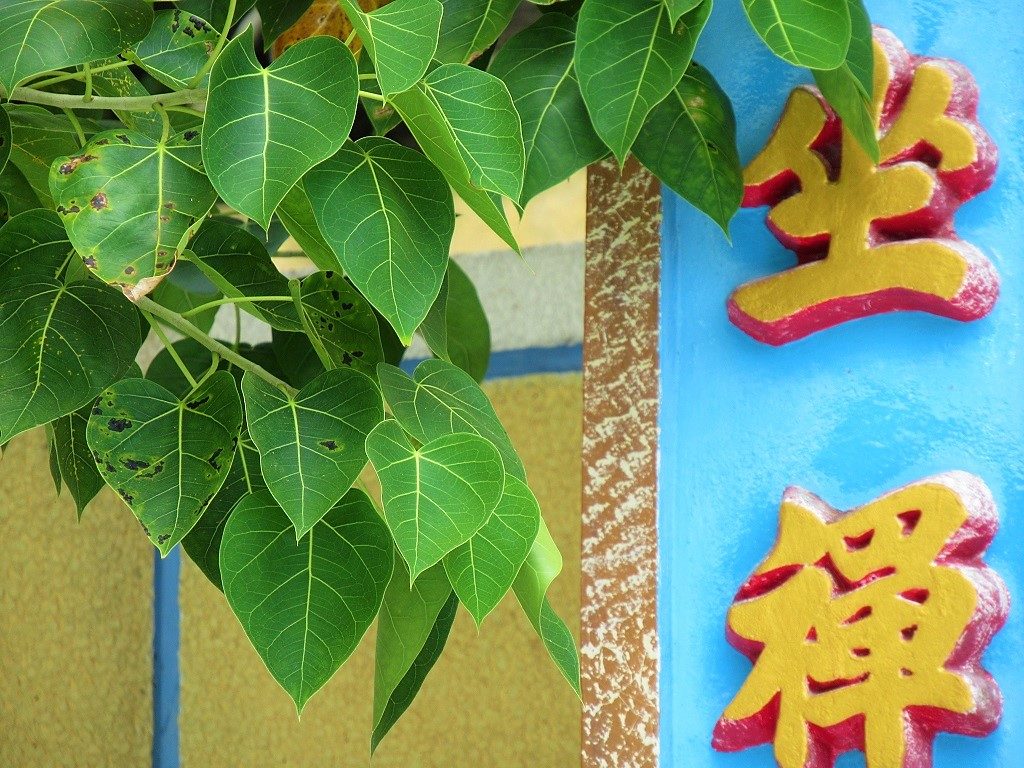

Peanut:
*Other names: Monkey nut | đậu phộng or lạc (Vietnamese)
*Where & when you might see it: Central & northern coastal plains [MAP]
A low, shrub-like plant, peanuts are grown in fields between homes and on farmland. For example, in the little back-lanes around Hoi An it’s common to find rows of peanut bushes growing in the alluvial soil near the Thu Bon River. Because the peanut plant is so small, and because the nuts grow underground, it’s easy to pass by without noticing it. In fact, it wasn’t until recently that a friend of mine pointed out the peanut crops all over the place as we travelled through Central Vietnam. The plants are green with small leaves that look like a herb bush. The nuts, which come in pods, are commonly used in Vietnamese cuisine as a garnish, to add crunch and flavour to a dish. For example, crushed peanuts are sprinkled on shellfish, or in noodle soups.
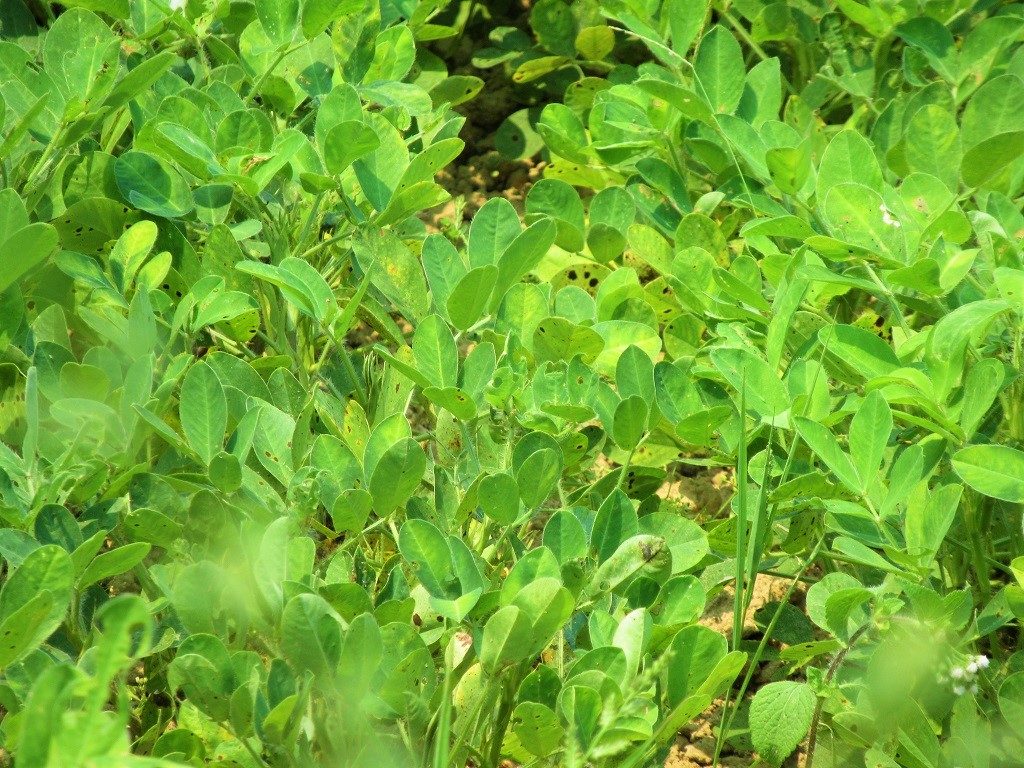
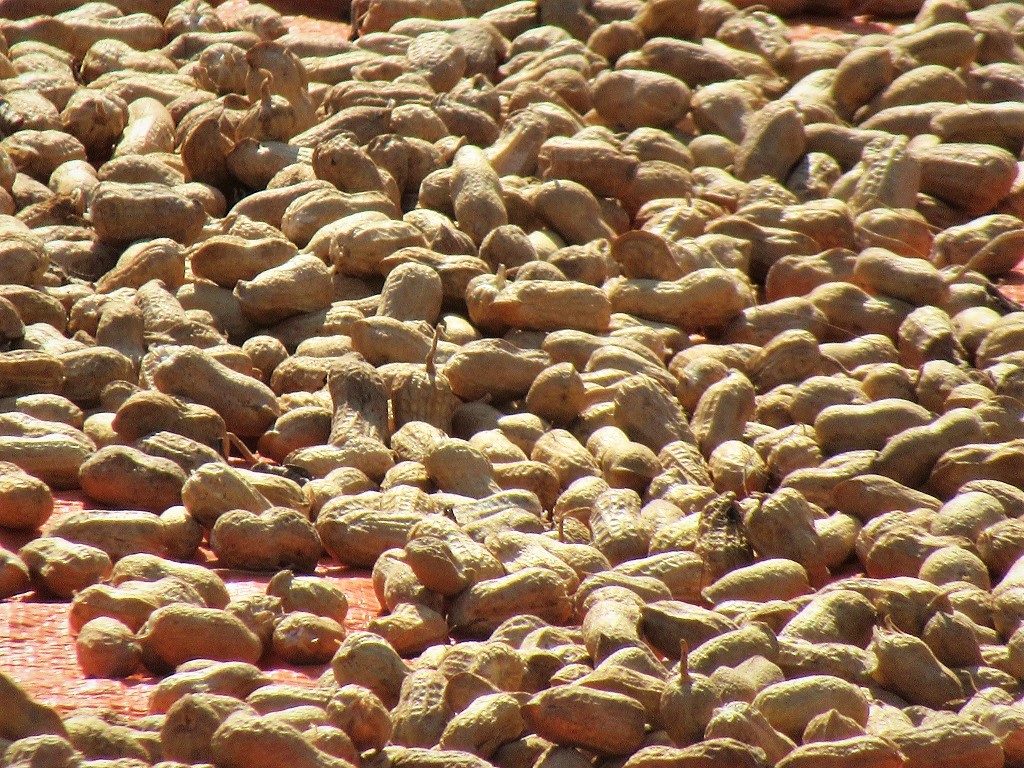
Cannonball Tree:
*Other names: Đầu lân (Vietnamese)
*Where & when you might see it: tropical forest regions, gardens [MAP]
The large, brown, spherical fruit of this medium-sized tropical tree is where it gets its name. The ‘cannonballs’ hang off the branches on vines, dangling close to the trunk from top to bottom; almost as though they were frozen while tumbling through the canopy. But, although it’s the cannonballs that give the tree its name, it’s the flowers that most appeal to me. Growing in clusters on the vine, the flowers are large, wide, and open. The petals are cream yellow on the outside and deep red on the inside, with pink and yellow stamens. The flower has a rubbery but fragile texture and the scent is glorious. Fortunately for me, there’s a blooming Cannonball Tree in the park where I swim in Saigon. (I’ve rarely seen one in the wild.) As far as I know, the name in Vietnamese means something like ‘Dragon Head’, which I think is referring to the flowers’ resemblance to the head of the dragons in New Year dances.

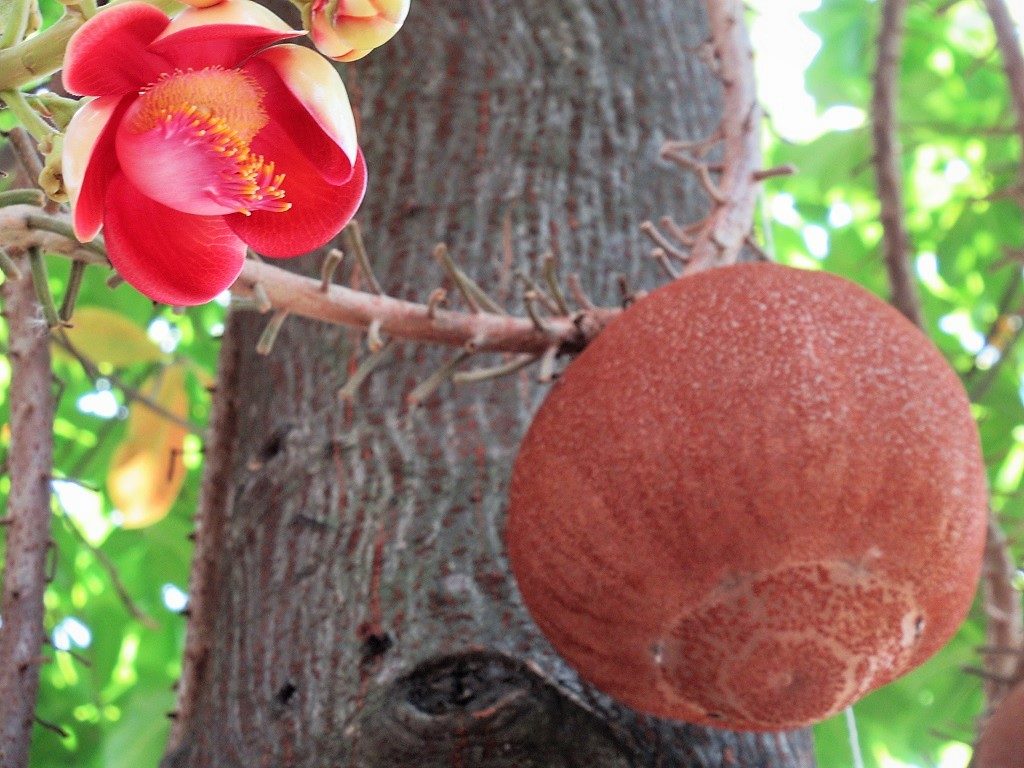
Bamboo:
*Other names: Tre (Vietnamese)
*Where & when you might see it: Rivers, hills & mountains nationwide [MAP]
Bamboo has poetic and romantic associations in Vietnamese culture, but it’s also a hugely practical plant. From homes to piping to food and utensils, Bamboo has long been one of the most useful, versatile and strong plants in the world. Bamboo apparently has the same tensile strength as steel – indeed, much scaffolding in Vietnam is bamboo. There are thousands of varieties of bamboo, of which you’ll see many as you travel through Vietnam, especially by the rivers and in the hills of the central and northern provinces. From spindly, delicate bamboo that look like a Chinese ink and water painting, to thick, sturdy columns that look like the pillars of a palace wall, Bamboo comes in all sizes and colours. And it grows profusely: at up to a metre a day, bamboo is one of the fastest growing plants on the planet. A particularly good place to see bamboo is on the back-roads of Thanh Hoa Province, where the hills and valleys are blanketed is a soft green bamboo canopy.


Cashew Tree:
*Other names: Cây điều, Đào lộn hột (Vietnamese)
*Where & when you might see it: Coastal & midland regions, especially south-central provinces [MAP]
Found in large open orchards in coastal and lowland regions in the south-central provinces, the Cashew is an attractive tree bearing the famous nut and a less well-known, juicy fruit. Cashew nuts grow in a surprising manner: they are attached to the bottom of the Cashew apple, which is an aromatic, thick skinned, red and yellow fruit. Once ripe, the fruit spoils quickly and its rotting remains fill the air was a pungent, but not unpleasant, smell. Indeed, along the Ocean Road you can usually smell a cashew tree long before you can see it. Vietnam is among the largest producers of cashew nuts in the world. Cashews are one of the more expensive nuts, but they can also be processed to make vegan-friendly dairy products, such as cashew cheese and butter. I’ve always liked the Cashew tree: it has low branches that grow out horizontally, creating an easily climbable ladder into the canopy. Because of their splayed branches and thick leaves, Cashews are also great shade trees: during the southern dry season, farmers, travellers, and cattle alike sit out the hottest hours of the day in the pool of cool shade beneath the Cashews.
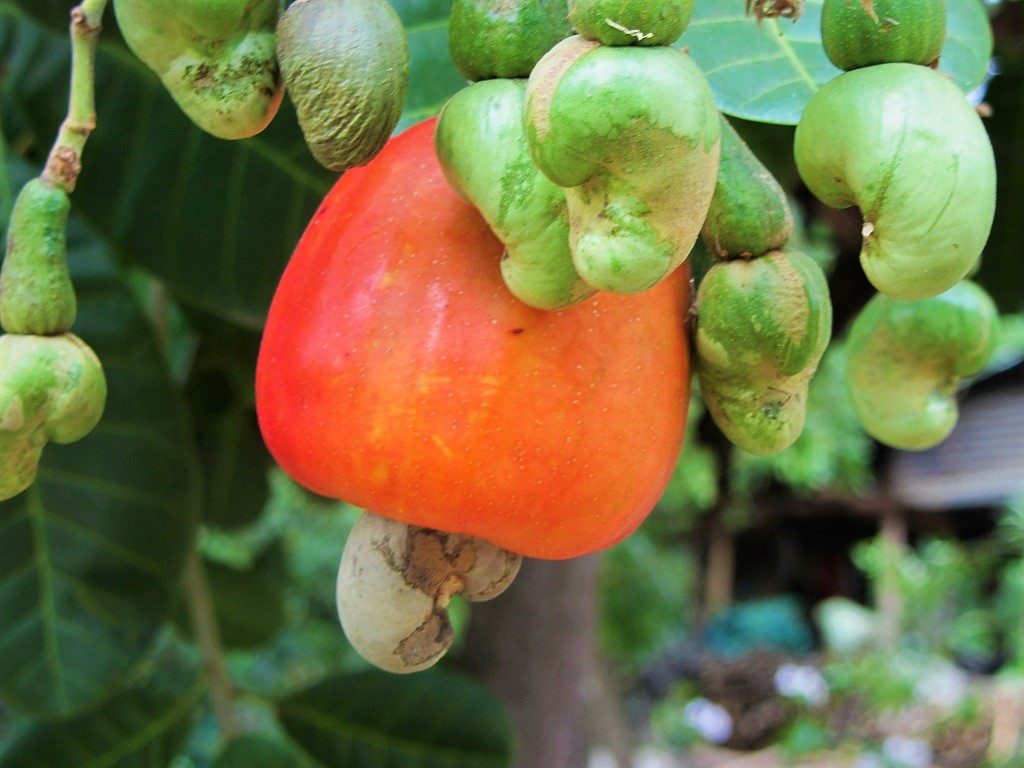

Mango Tree:
*Other names: Cây xoài (Vietnamese)
*Where & when you might see it: Coast, lowlands, deltas, midlands & some highlands nationwide [MAP]
Surely one of the most loved tropical fruits, Mangoes are available all over Vietnam, although slightly less so in the more temperate climate of the northern provinces. In south and central provinces, however, Mango Trees grow in people’s gardens, by the roadsides, in orchards, and on hillsides. Mango Trees have a pleasing symmetry to their canopy, splaying out near the base and rounding off nicely at the top. Some Mango Trees can be very tall and old with thick, knobbly trunks. There are dozens of varieties of Mango. In Vietnam, green, unripe mangoes are a popular snack or are finely shredded to use in salads. Unripe mangoes are crisp, sour, crunchy and refreshing, with a beautiful, floral smell and flavour. Ripe, orange and yellow mangoes are sweet, juicy, soft, luscious, and sticky. They’re used in smoothies and desserts.

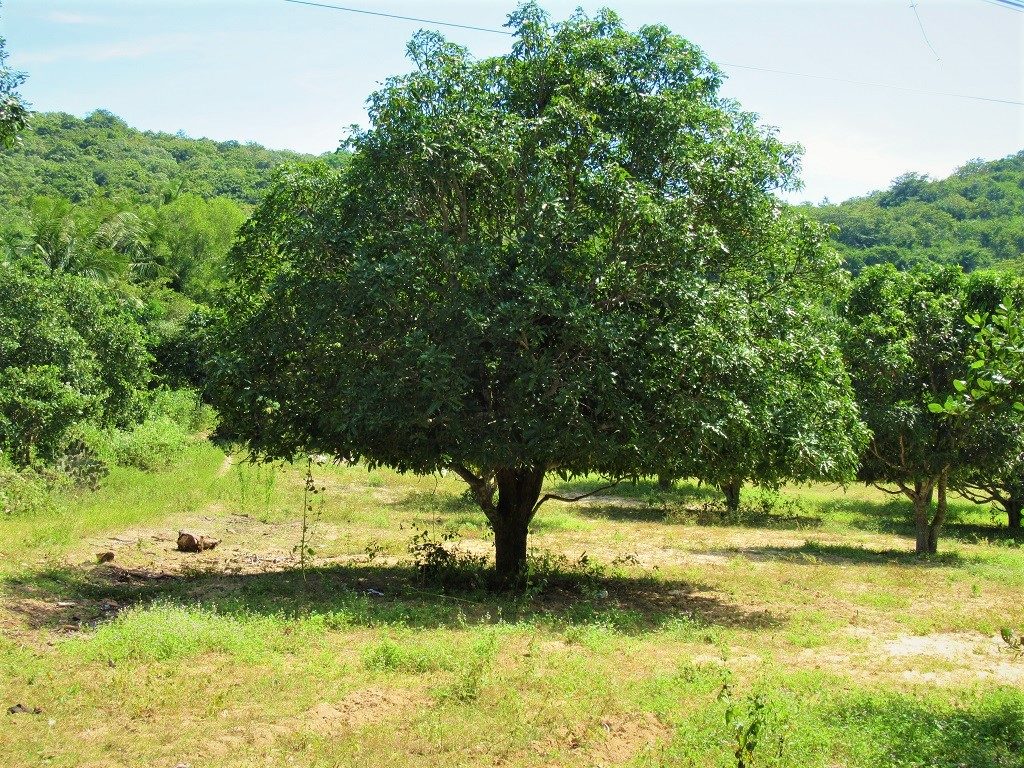
Coffee Bush:
*Other names: Chi cà phê (Vietnamese)
*Where & when you might see it: Central & northern highlands & midlands [MAP]
As one of the world’s largest producers and exporters of coffee, parts of the Vietnamese countryside are completely blanketed in coffee bushes. Growing to a height of about 1-4 metres, coffee bushes are squat, glossy-green-leafed shrubs. In Vietnam, since the 1980s and 90s, coffee production has soared. The Central Highlands region, in particular between Bao Loc, Dalat and Buon Ma Thuot, underwent huge transformation to accommodate the profitable cash crop. When travelling to Dalat by road, for example, vast swathes of forest have been cut down, replaced by coffee bushes as far as the eye can see. Amazingly, most of the coffee farms are smallholds, often harvested by one family. During harvest time, between October and January, the berries (each of which contains two coffee beans) are picked by hand and dried on the roadside or in the yards of farmer’s homes, before being processed and sold to middlemen. The majority of Vietnam’s coffee is Robusta, which is a tough, high-yield, but poor quality variety. Most of this crop is sold to instant coffee giants, such as Nestle. Increasingly, however, farmers are turning to the Arabica variety, which only grows at high altitude and is quite delicate, but brings a much higher price. The area around Khe Sanh, in the central province of Quang Binh, produces some of the best Arabica coffee I’ve ever tasted. What’s more, Vietnamese coffee culture is becoming more and more sophisticated, trendy and, hopefully, environmentally conscientious. One aspect of the coffee plant that gets overlooked is the white, star-shaped blossom, whose beautiful aroma fills the highlands when in bloom. Coffee blossom tea and honey are justifiably gaining a reputation.
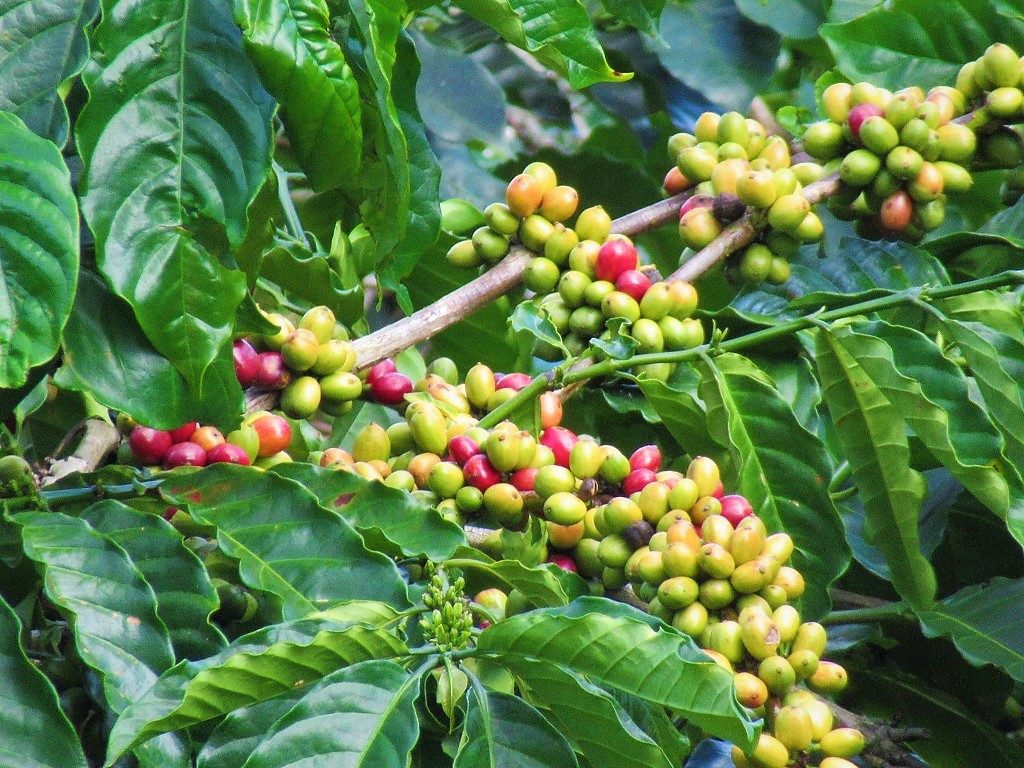

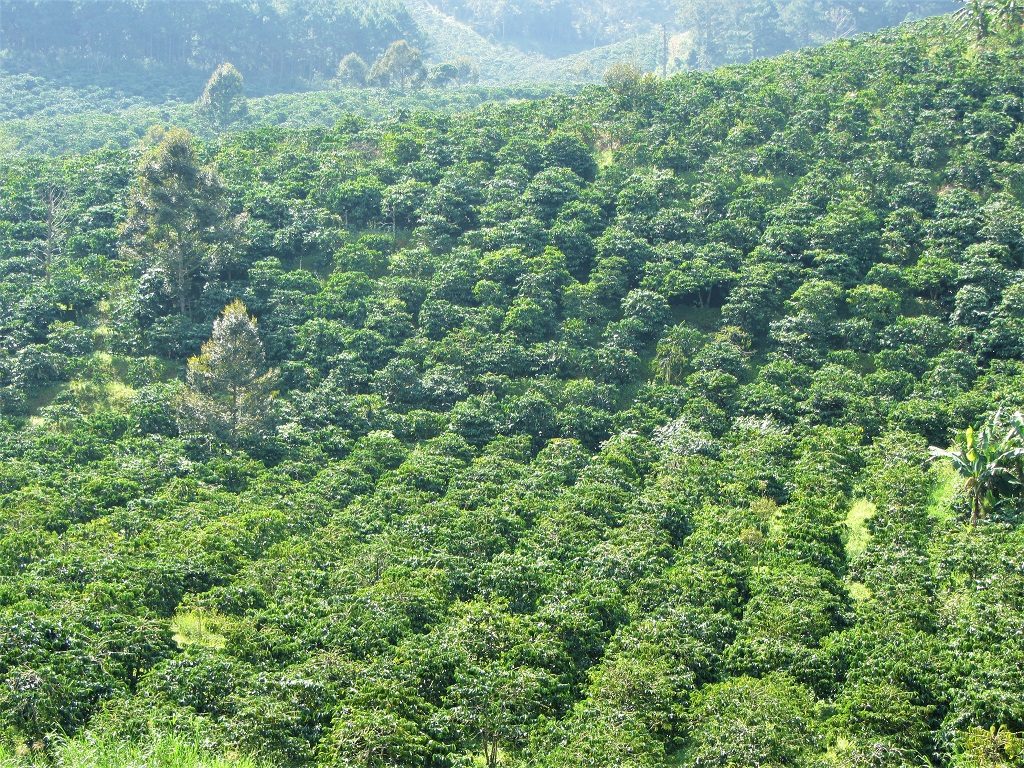
Breadfruit Tree:
*Other names: Cây sa kê (Vietnamese)
*Where & when you might see it: Coast & lowlands in southern & central provinces [MAP]
A handsome, medium-sized tree with large, green, coarsely textured, serrated leaves, the Breadfruit is quite common in Vietnam as an ornamental tree on city streets and in gardens. The big, green-yellow fruit (similar in appearance to Jackfruit) is used in some dishes as a starchy alternative to any kind of potato. Breadfruit is particularly good when sliced, battered and lightly fried in oil to produce a crispy, flat chip (or fry), which is great for dipping in a sauce. I’ve heard two stories about the origin of its name. The first is that the fruit’s texture, when cooked, resembles freshly baked bread. The second is rather more chilling. The British Empire was in need of a cheap, fast growing, high-yielding, high energy food source to feed its population of slaves on plantations in the Caribbean, on the backs of whose labour so much money was made and some many people depended. The Breadfruit, which is high in carbohydrates, was discovered in another British colonial realm, the South Pacific. Its potential as a ‘slave feed’ was quickly realized and the tree was soon exported and grown on the Caribbean islands. As the staple of the slaves diet, it became know as ‘Breadfruit’.
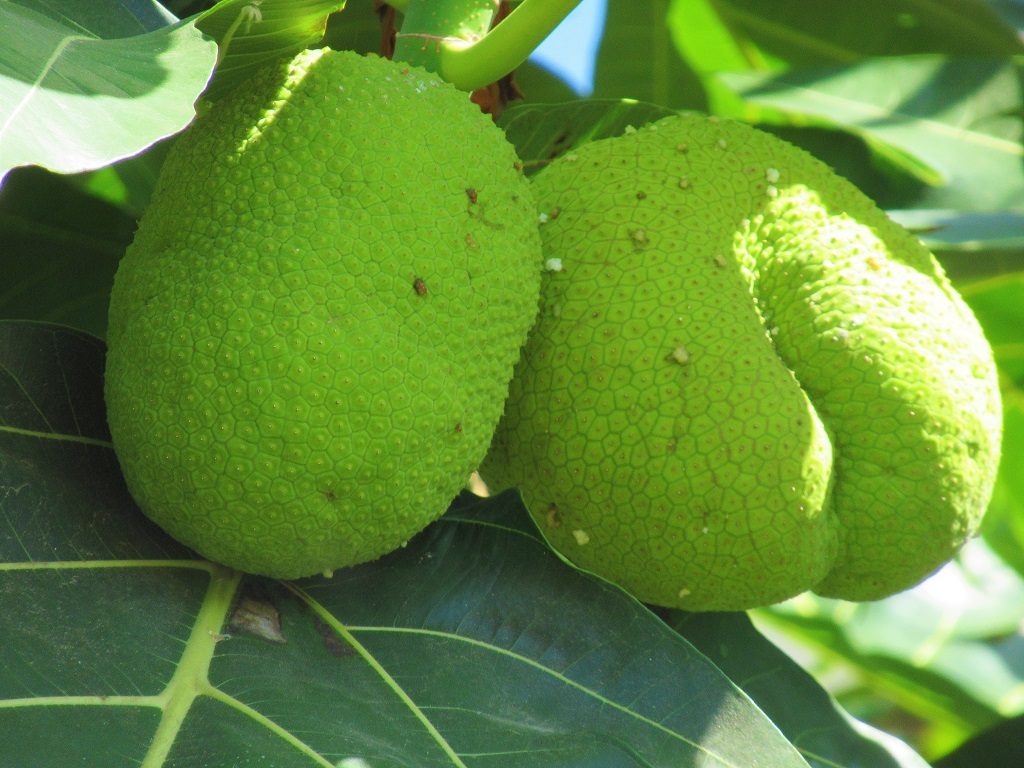
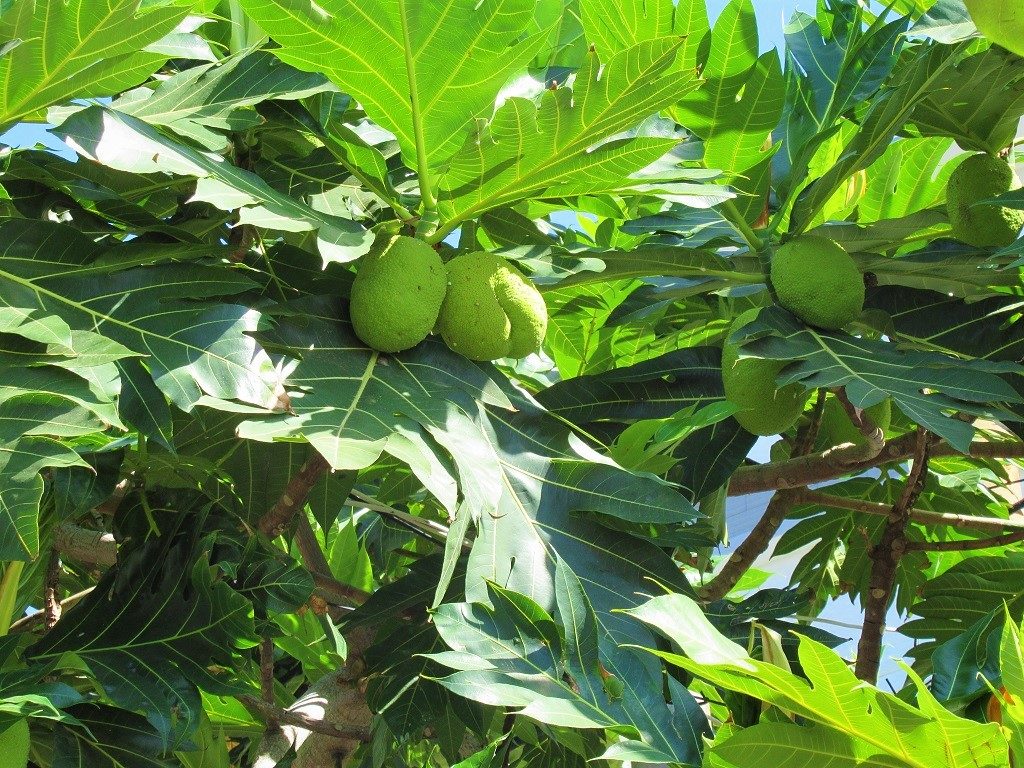
Disclosure: I never receive payment for anything I write: my content is always free and independent. I’ve written this article because I want to: I like flora and I want my readers to know about it. For more details, see my Disclosure & Disclaimer statements here
[Back Top]

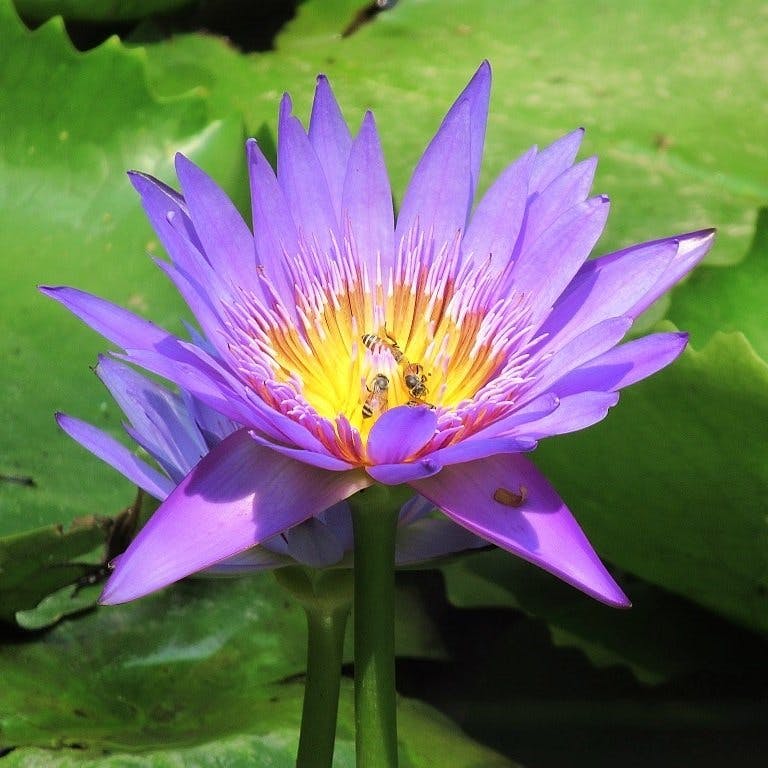
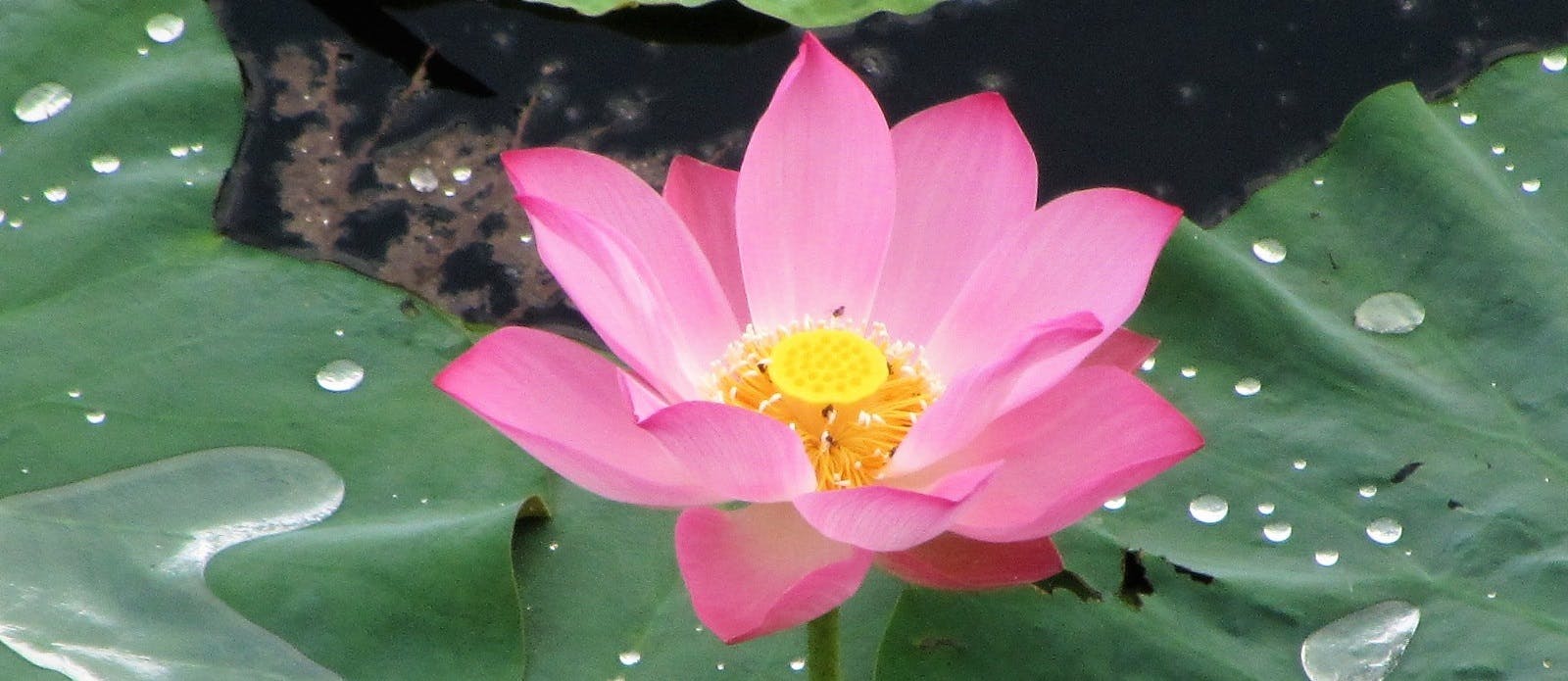

i love all of flowers
Could you upload pictures of the Bidoup and Bao Lâm oak trees from the Lâm Dông province? They are under treat and recently (first days of Sept. 2022) a Swiss fund adopted them for saving. And when you’r at it, could you give the Latin name of the Bao Lam?
Thanks.
Great website, by the way. It’s beautiful.
Hi Ratana,
Thanks for your comment.
I don’t have any images of that tree, sorry.
Best,
Tom
It’s worth noting that the majority of the plants listed are not originally from Vietnam. Most of these are introduced plants, many from Central and South America, and a fair number of them are environmentally damaging invasive plants.
Hi,
Yes, I’m not suggesting these plants are native to Vietnam, only that they are commonly seen in Vietnam.
Tom
Hi Tom, love your work. Just a snippet about the Traveller’s Palm, they also orient East-West so good for a rough compass when your needing to know the direction.
Cheers
Steve
Hi Steve,
Thanks, that’s really interesting. A good reference point if you’re ever lost!
Best,
Tom
Nice article about Vietnam trees BUT,
I cannot see any mention of the Xuân Đầu tree
which we have in our garden in Saigon.
Have I missed it?
Regards, Mr.John
Hi John,
Is is ‘xuân đầu’ or ‘đầu xuân’? I can’t find much about it.
The name means ‘early spring’ so it sounds like a colloquial name for what I would imagine refers to one of the Tết flowers, such as Hoa Mai which you can see on this page.
If not, then I don’t know the tree. This page is just a list of plants, trees and flowers that I see regularly and love; it’s not an encyclopedia of all Vietnam’s flora.
Best,
Tom
Hi Tom, thanks for this guide. The bodhi tree illustration is confused. It’s the leaves of the ‘tra bồ đề, tra lâm vồ (Thespesia populnea)
Hi, thanks.
Isn’t that a type of bodhi tree?
Tom
hi Tom,
im looking for bàng tree , I couldnt find it in your list, could you tell me what is its name in english please?
Hi Elham,
Yes, sure: the bàng tree is the Tropical Almond in my list – it has several different names.
I hope this helps,
Tom
Hi Tom, someone gave me a piece of plant said it was from Vietnam Nam. It has grown beautiful and I want it to keep me company for a long time. It’s about 3 ft. Tall and leaves grow on the sides. Is there a change you know the plant and how to take really good care of it.
Hi Elba,
I might do. Can you send a picture of it to my email: vietnamcoracle@gmail.com
Tom
I sent the picture of the cannonball flower and fruit to the Vietnamese state rep in the district next to mine. She’s beautiful, but a cannonball when she needs to get things done… I will try dragonfruit and fried breadfruit, though in Massachusetts we have to wait till they get (maybe) ripe enough to eat. Never thought to check online for the color they should be. Your website is inspiring me to try things that I never had time to think about when I was working!
Thanks so much!
Thanks, Patti.
I love the cannonball tree – definitely one of my favourites. Yes, try the fried breadfruit – it’s delicious!
I’m very happy to hear you’re finding some things to fill your time with from my site 🙂
Best,
Tom
What a great post!, I really enjoyed reading this it has inspired me to do little check off like you did. I live in Vietnam and always finding myself looking at all the beautiful flowers in awe. Where did you find your tropical plant and flowers book?
Thanks!
Thanks, Alex.
I can’t remember where I bought my flower books, but you can find them online quite easily – I’ve written more about the books on this page.
Tom
I love beautiful plants and flower in Vietnam. Would you please help me looking for Mac Mot seed in Vietnam
We use the leave for cooking.
Van Baccam
Thank you
Hi Van,
I think you’re probably referring to mắc mật.
In my experience, I find it more in the northern provinces than the southern. But I think if you go to any local market in Vietnam and ask for hạt mắc mật you should be able to find it.
Good luck,
Tom
Hi, Thank you very much for your article. t’s great. I am an ikebanist living in Hanoi. I love flowers and trees. I wonder if you know the name of tre that has red flower that sort of remind me a pelican feat. I saw some around West Lake in Hanoi. I can email a pic.
Thanks a lot for your help.
Hi Paola,
Yes, please email me a picture of the tree: vietnamcoracle@gmail.com
Thanks,
Tom
Awesome guide to trees from Vietnam! I am not from Vietnam but was thrilled to see so many trees that are also found in India that I had known as a kid but had forgotten about or didn’t know the names of. Thanks for the wonderful guide – both write up and pictures!
Hi Gopal,
Thank you, I’m glad you enjoyed it. And, yes, I remember seeing many of these plants when I was in India too.
Tom
Hi Tom,
I love flowers and plants . Your article is very informative.
There are two plants that listed here.
– One of them is Sweet pea, Sweet pea is a vine.The pictures are for Yesterday today& tomorrow( Brunfelsia Grandiflora), yesterday today and tomorrow comes from the flowers that open purple, fade to lavender and then white
-Second one is Ixora. Ixora is a tropical to semi-tropical evergreen shrub, that usually available at local nurseries in red, pink or yellow.. The one picture that you have for Ixora is Hydrangea , colors beguile with clear blue, vibrant pink, frosty white, lavender, and rose blossoms—sometimes all blooming on the same plant
I have them in my back yard,
Hi Kim,
Thank you for the information and corrections. That’s very helpful.
I’m no expert on flora, I just wanted to make an illustrated list of some of the plants, flowers and trees that I regularly see in Vietnam so that other travellers can also identify them.
Yesterday, today & tomorrow is a lovely name for a plant.
Best,
Tom
Hi Tom,
Your article is amazing. I love plants as well.
I want to correct one thing.
Morning Glory: *Other names: Convolvulus | hoa rau muống (Vietnamese)
It is not “rau muống” (which is water spinach) in Vietnamese, it should be “bìm bìm”. Although they are the same family, but these are 2 different plants.
Thanks
Hi Hang Pham,
Thank you, it’s great to hear you love plants, too. And thanks for the correction.
Best,
Tom
Thank Tom for great topic.
Flaming Trumpet is also called “hoa chùm ớt” or “hoa rạng đông”. There is a man planting this flower to cover his roof of the house in Bao Loc, Lam Dong.
Hi Chau,
Thanks for the information – I’ve just updated it.
Tom
Really cool. Have you seen the iNaturalist app? It is from the California Academy of Sciences and National Geographic but works anywhere in the world. It is pretty good for this kind of thing, though there aren’t that many observations from Vietnam yet.
Hi Justus,
Yes, I’ve heard of the app, but never used it. Sounds great, especially when travelling.
Tom
A great piece of work, Tom
A visual delight.
I wish we had it on our travels.
Thanks, Vicki. I’m glad you like it. There are lots more to index, too.
Oh this is superb! And the photography! Thank you Tom.
Thanks, John. I’m glad you like it. I’ll be adding to it each week, too.
Tom